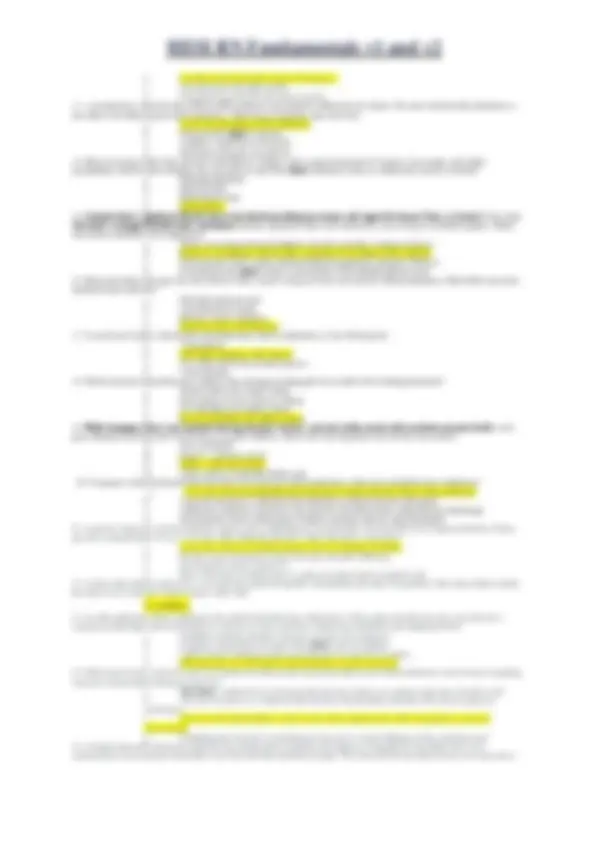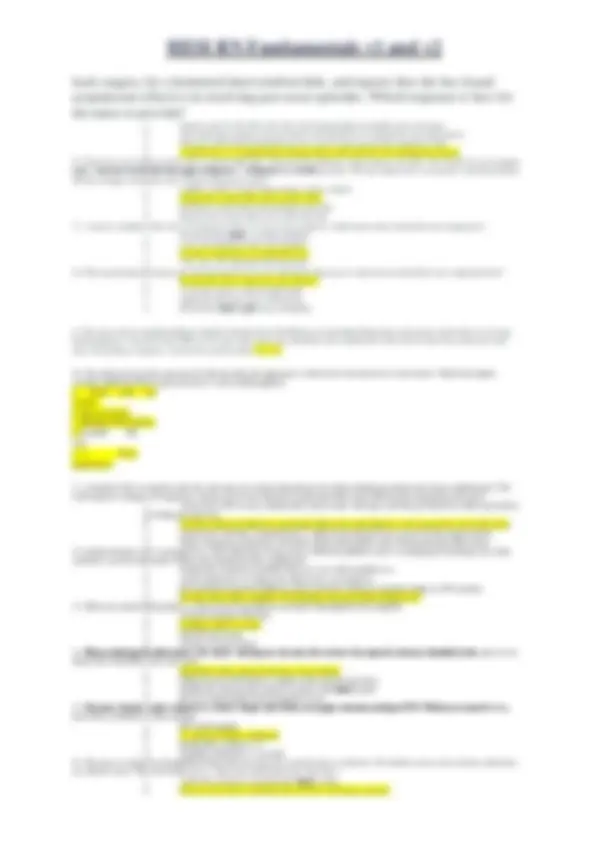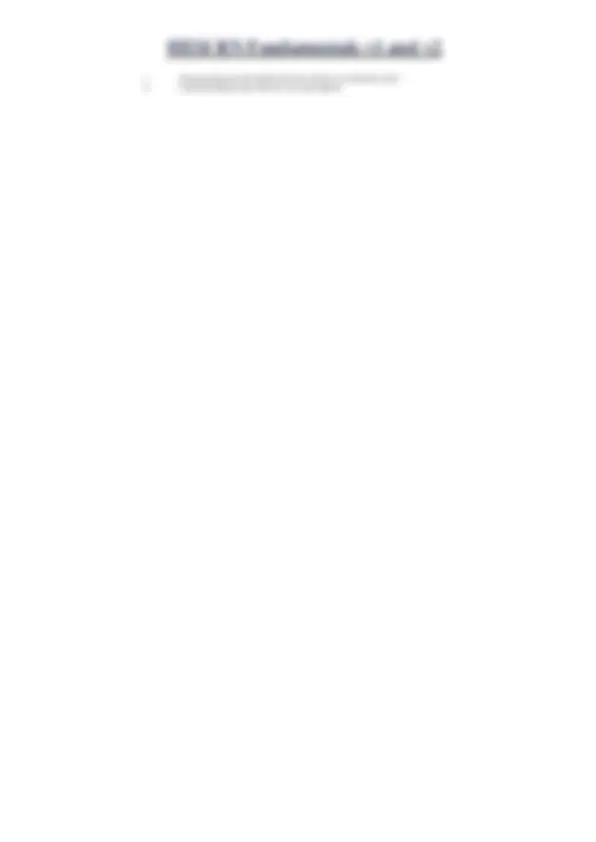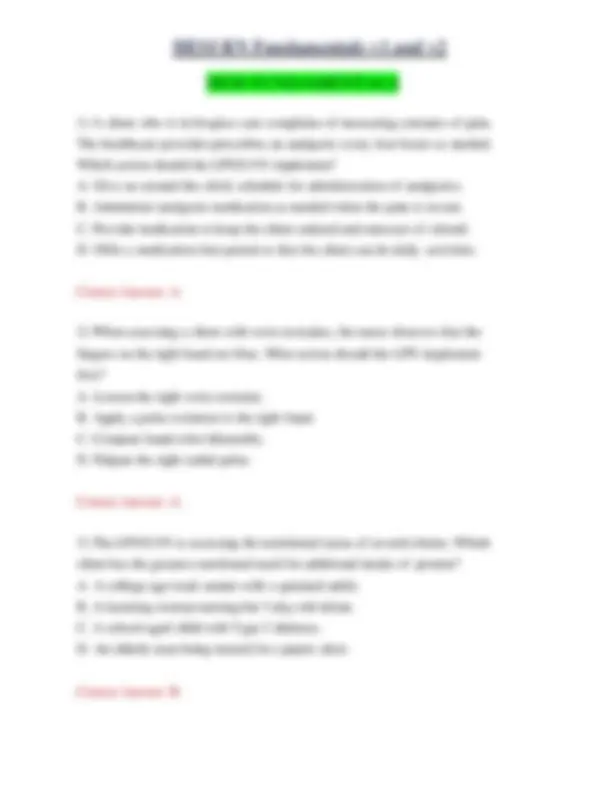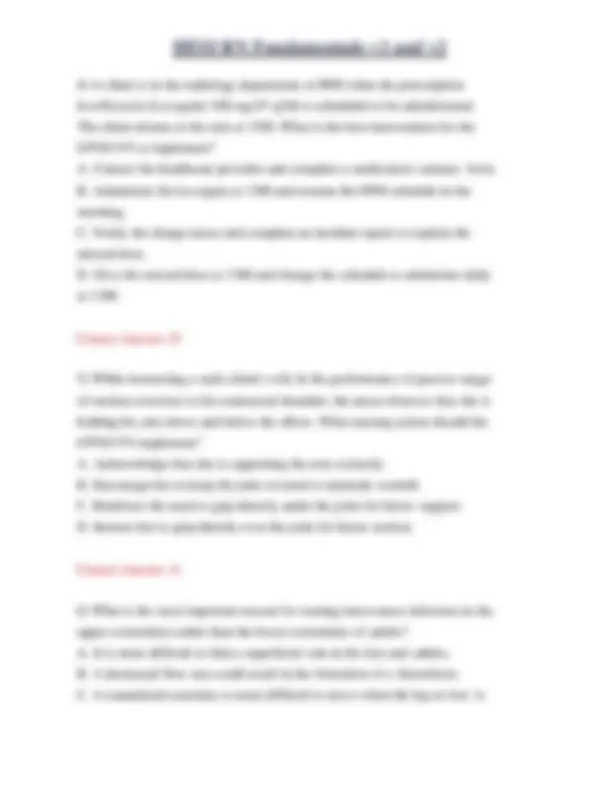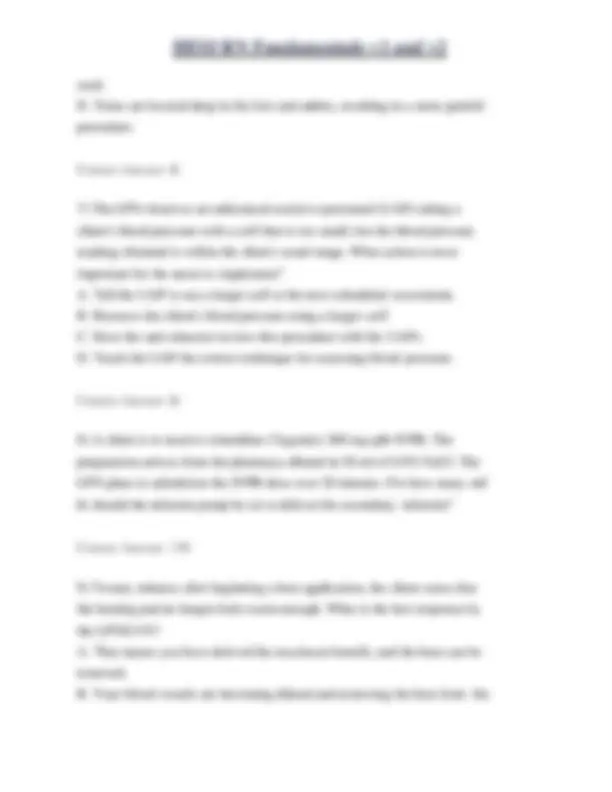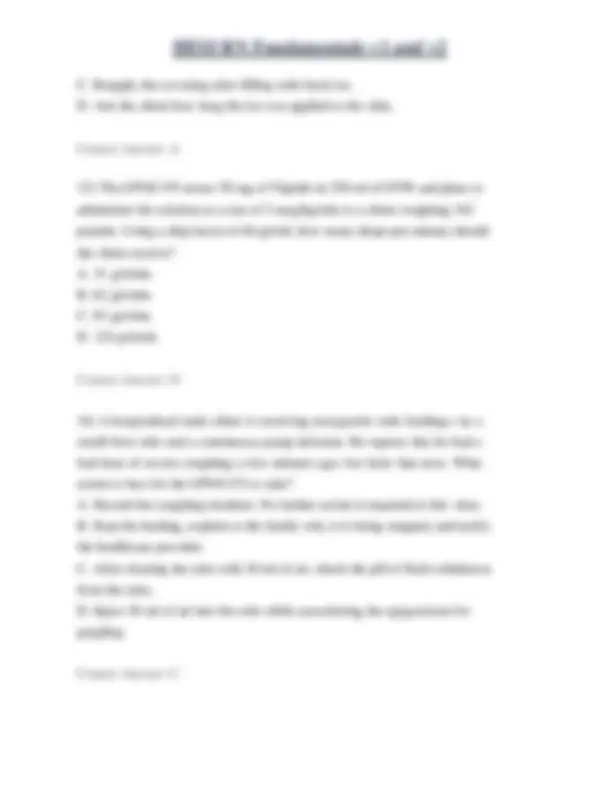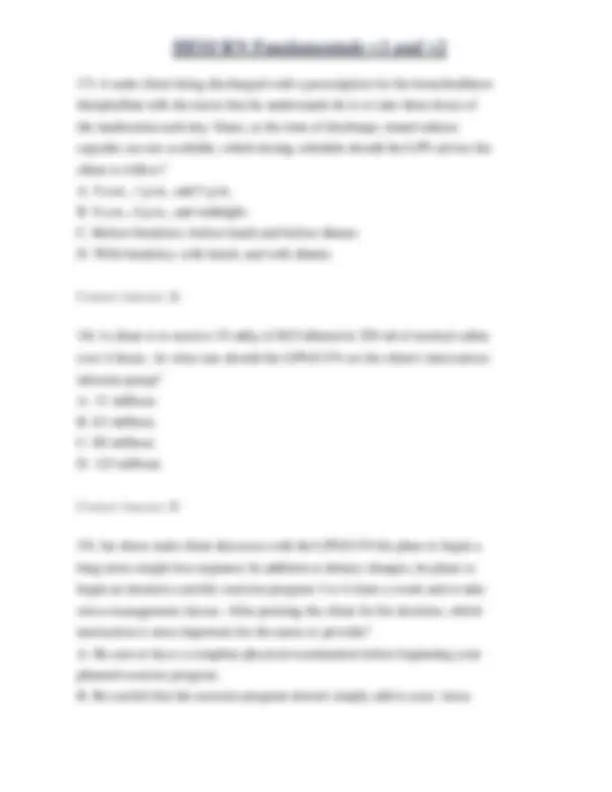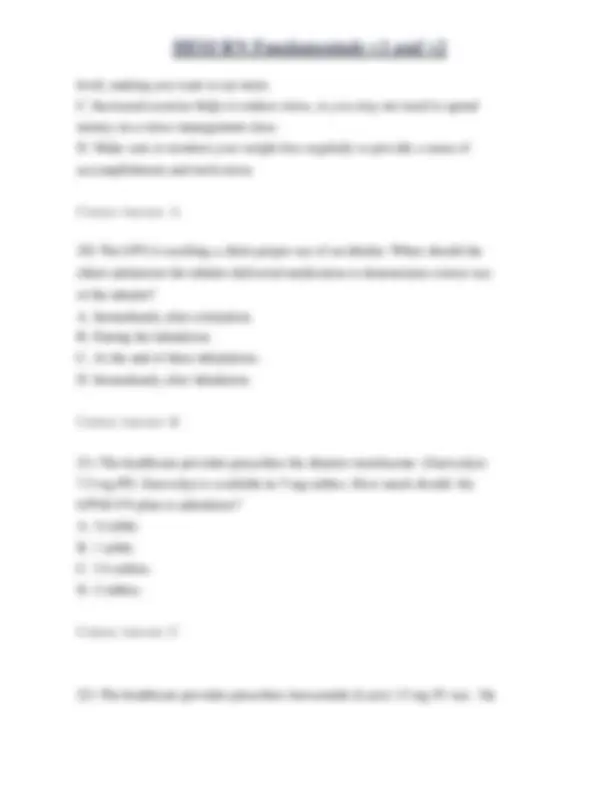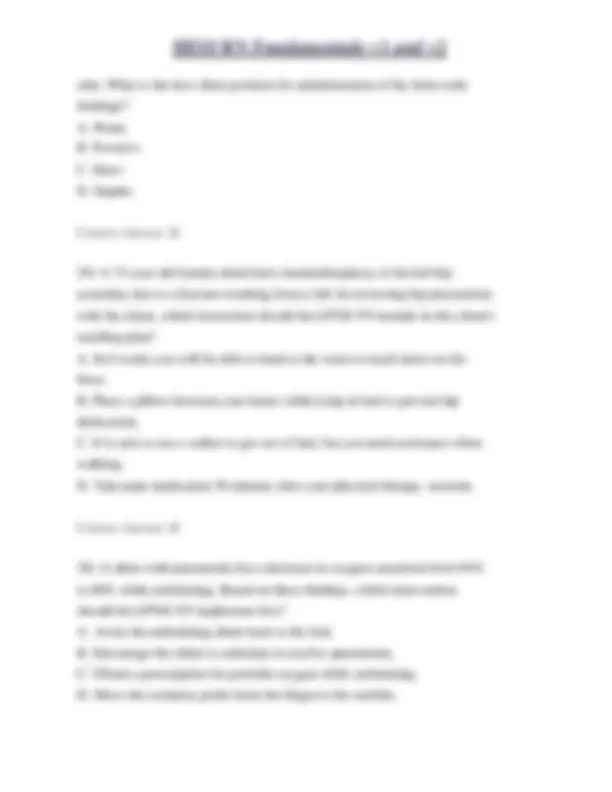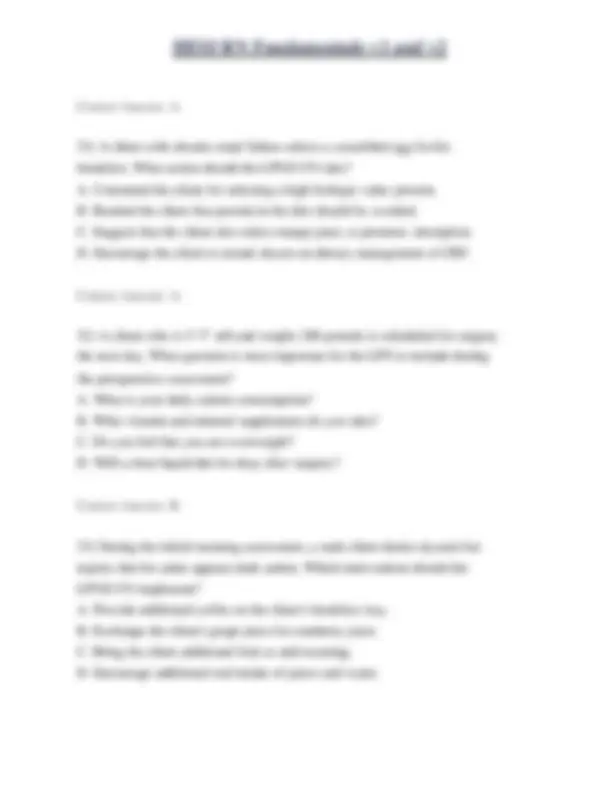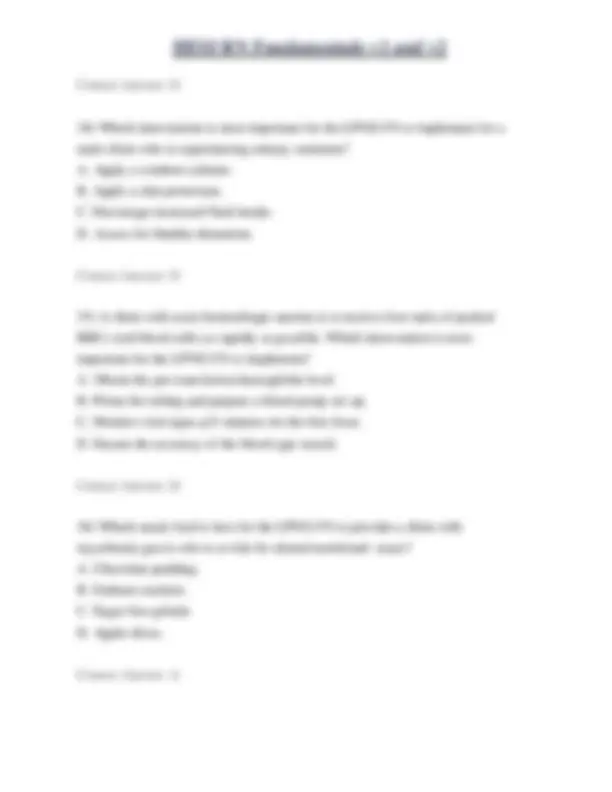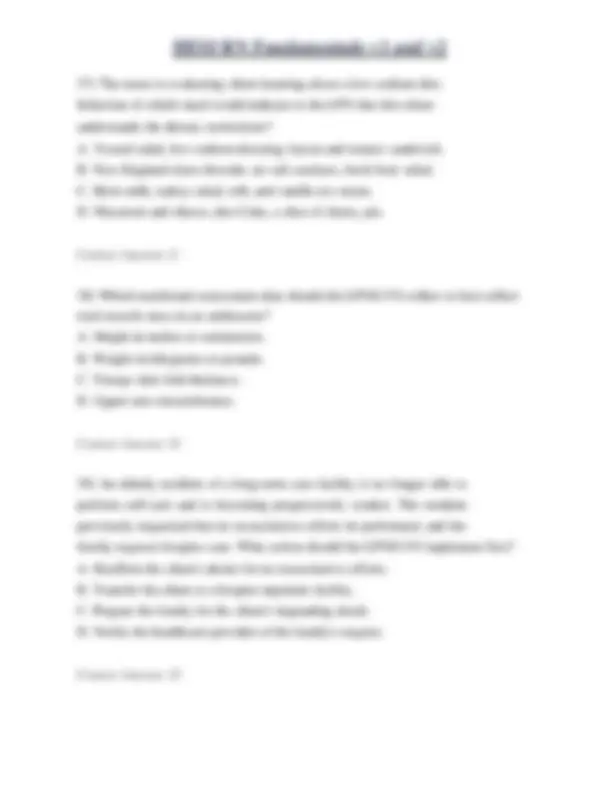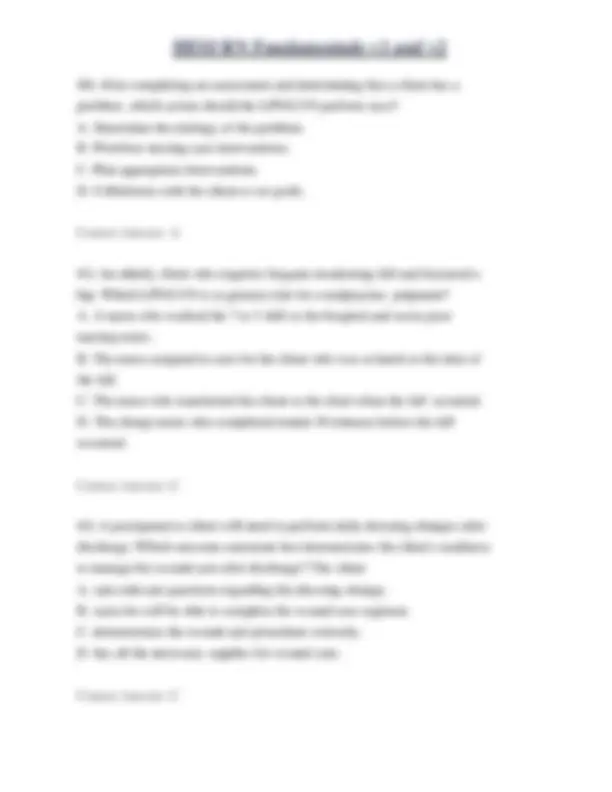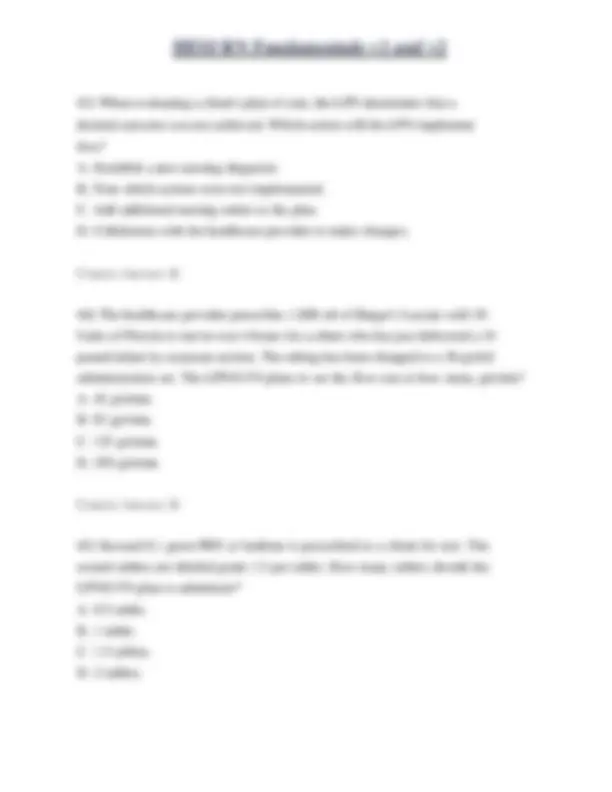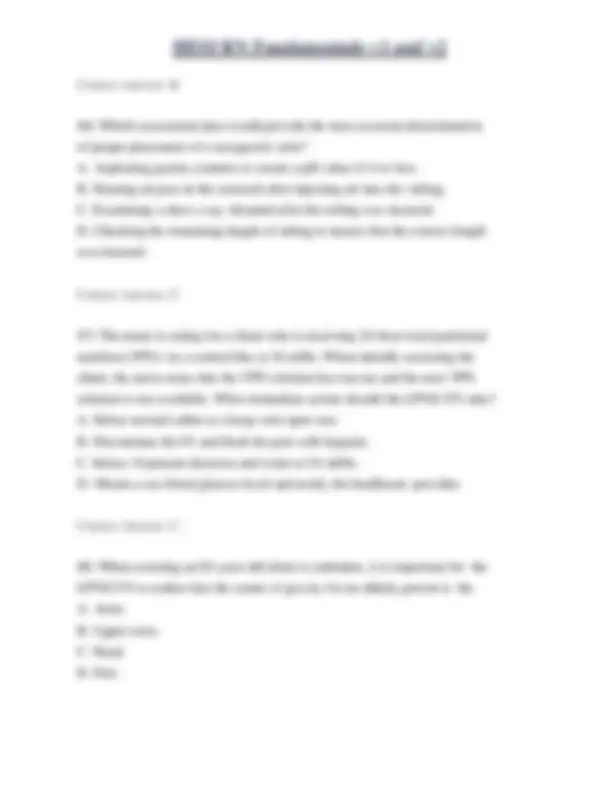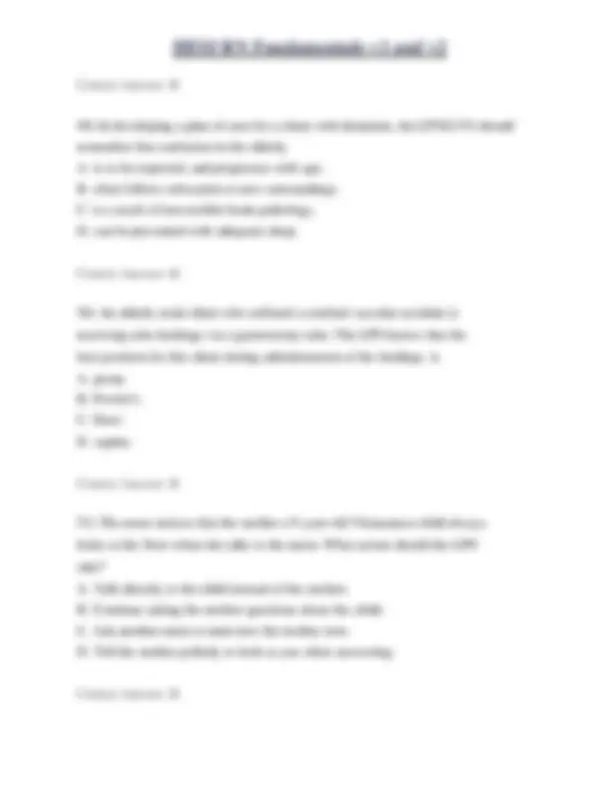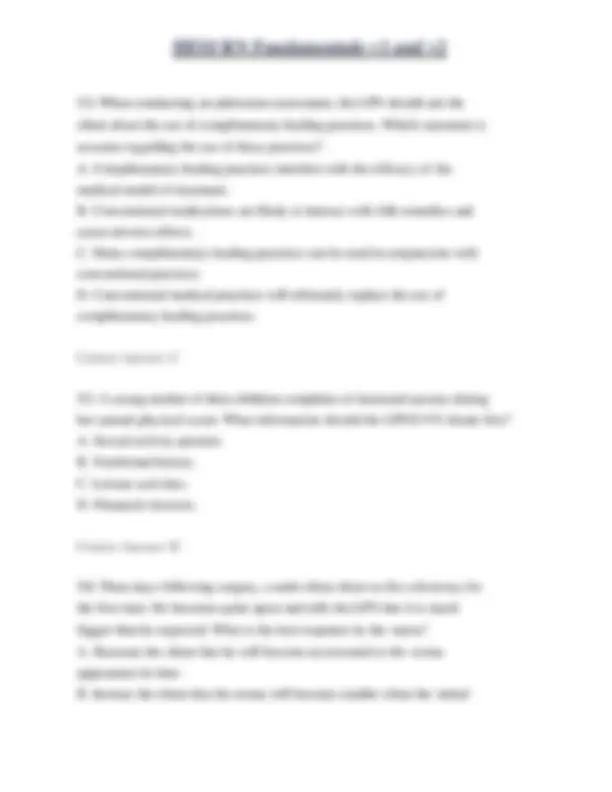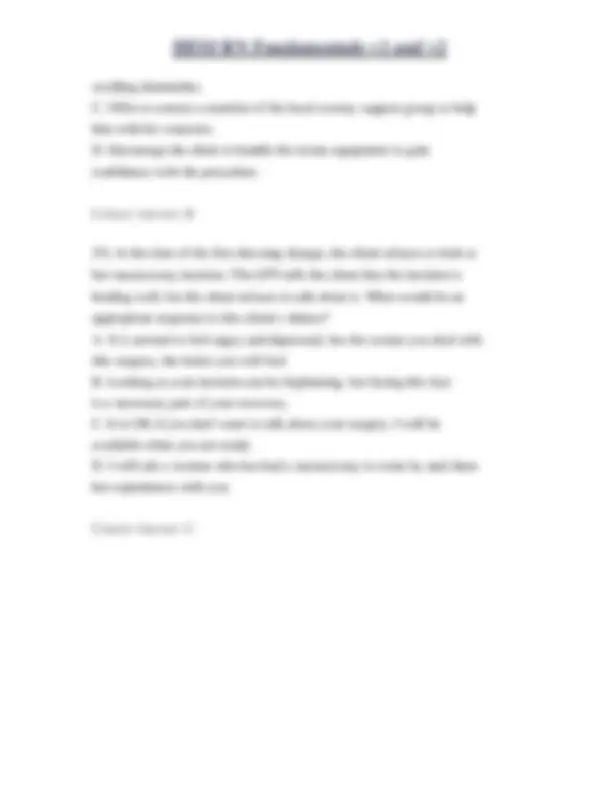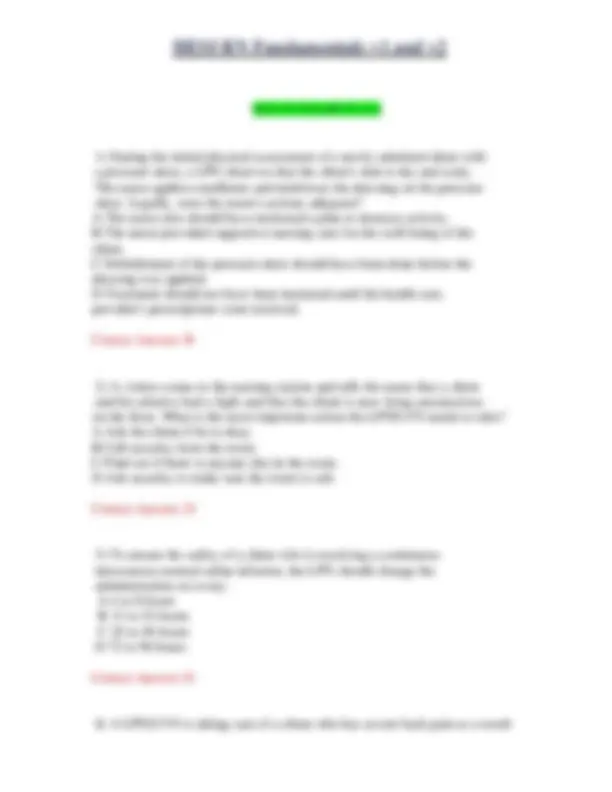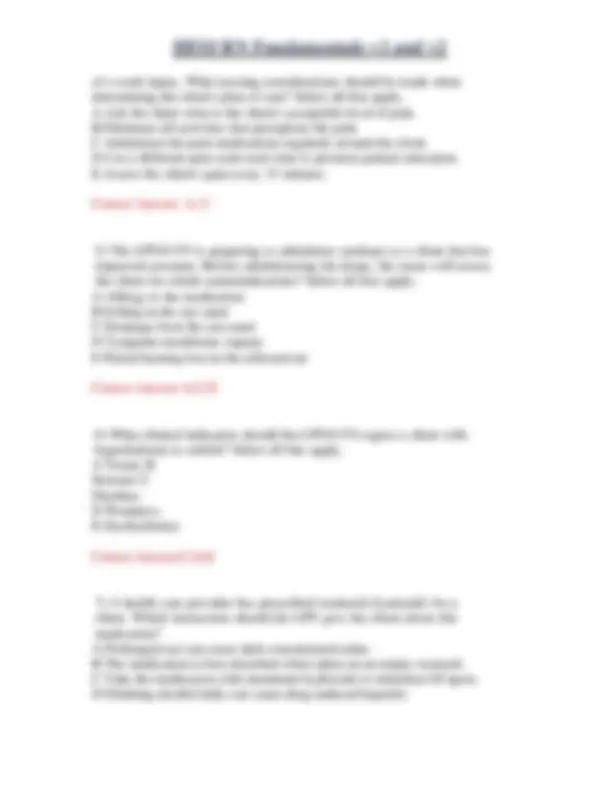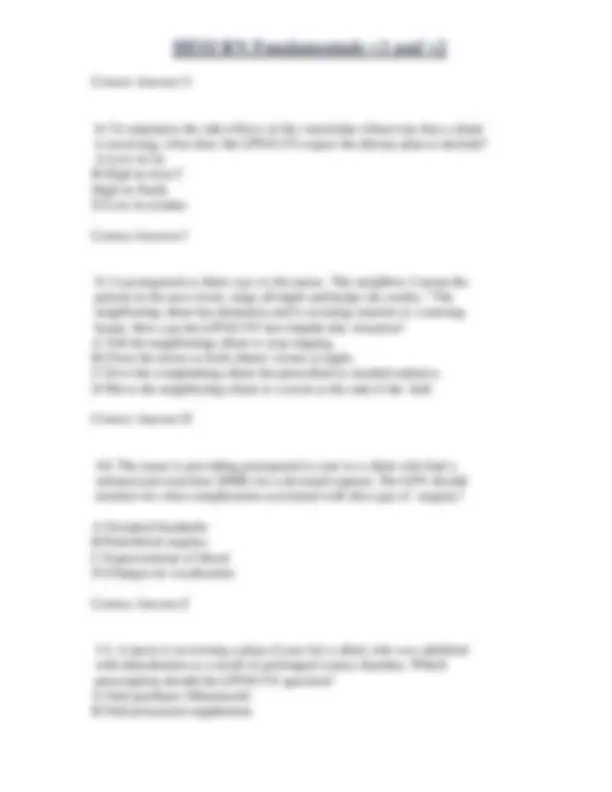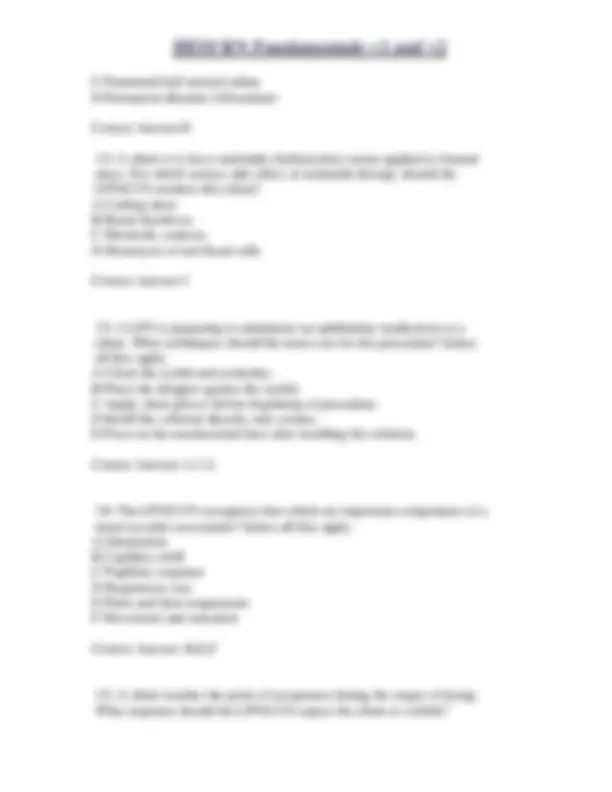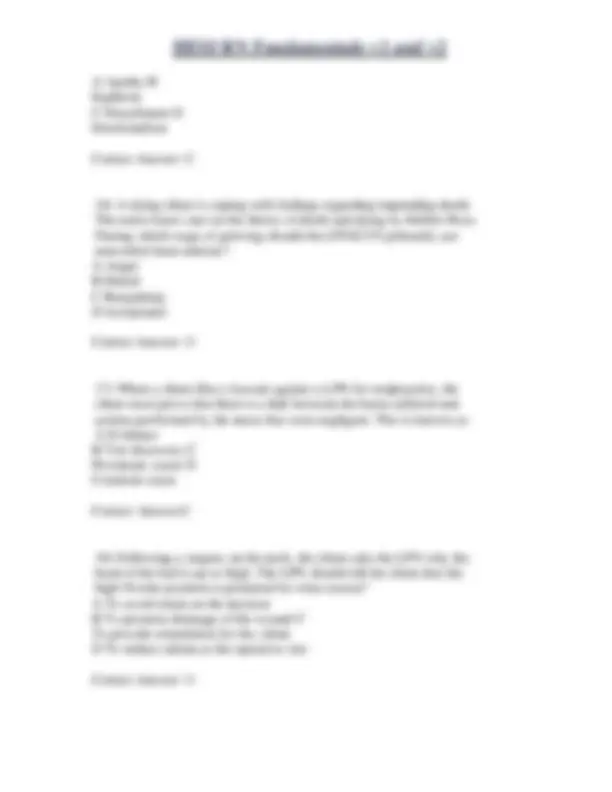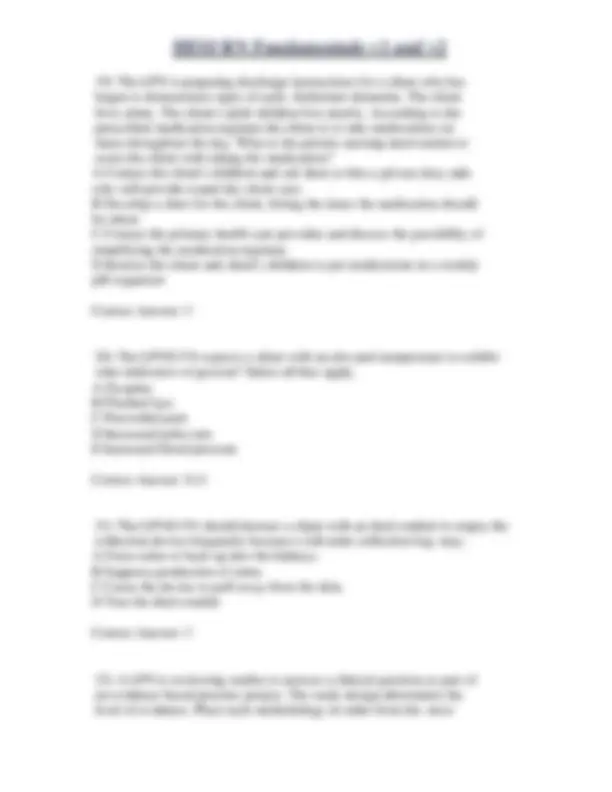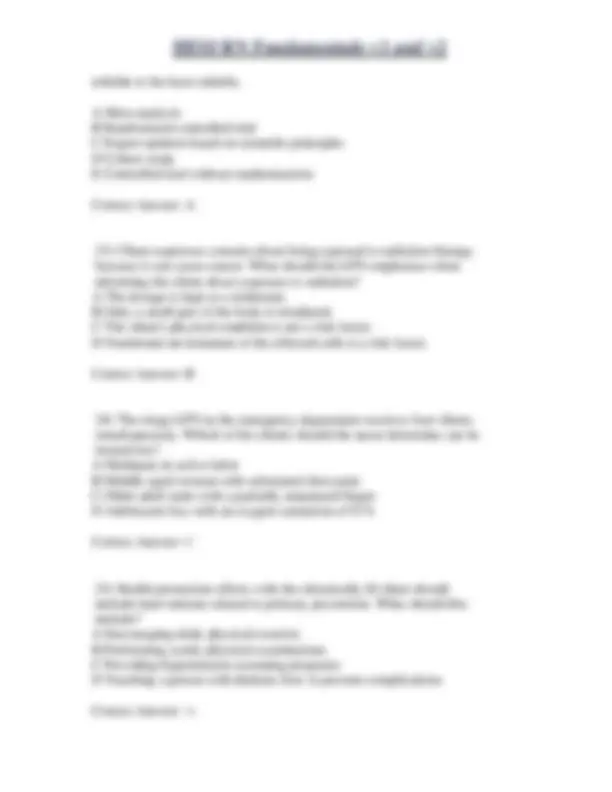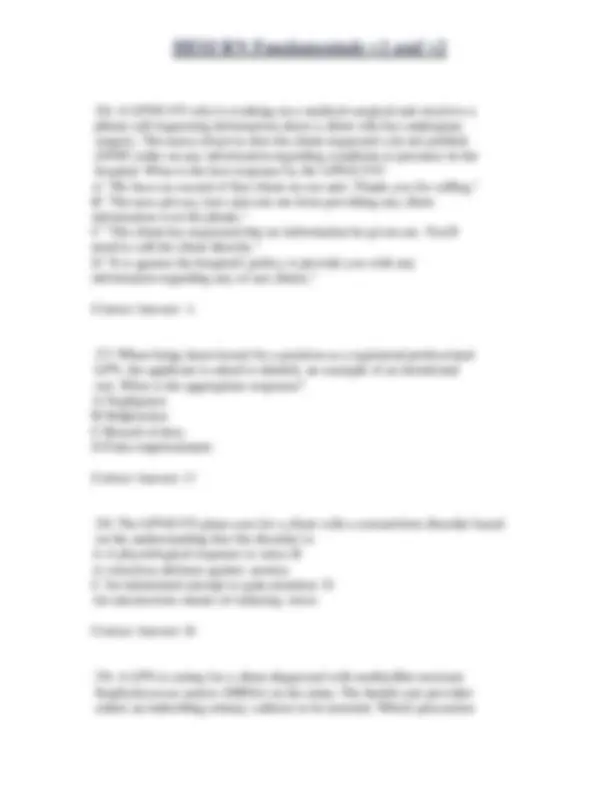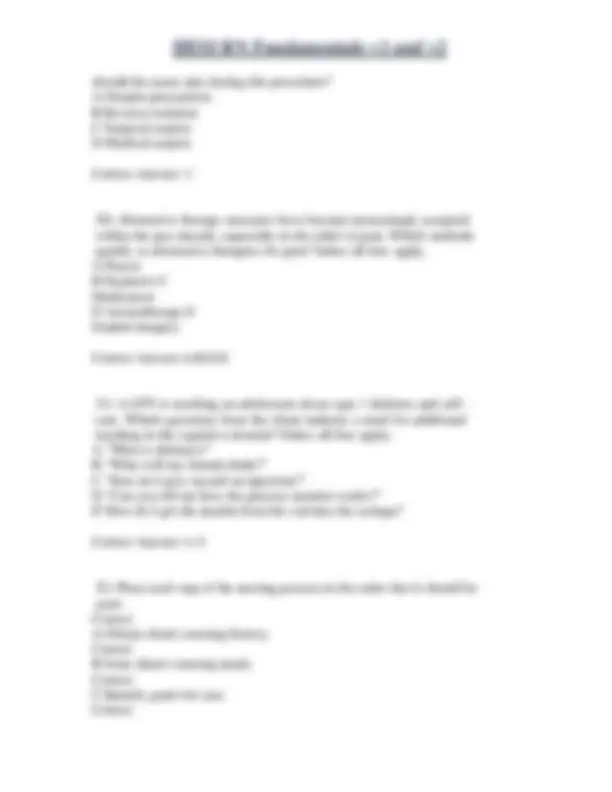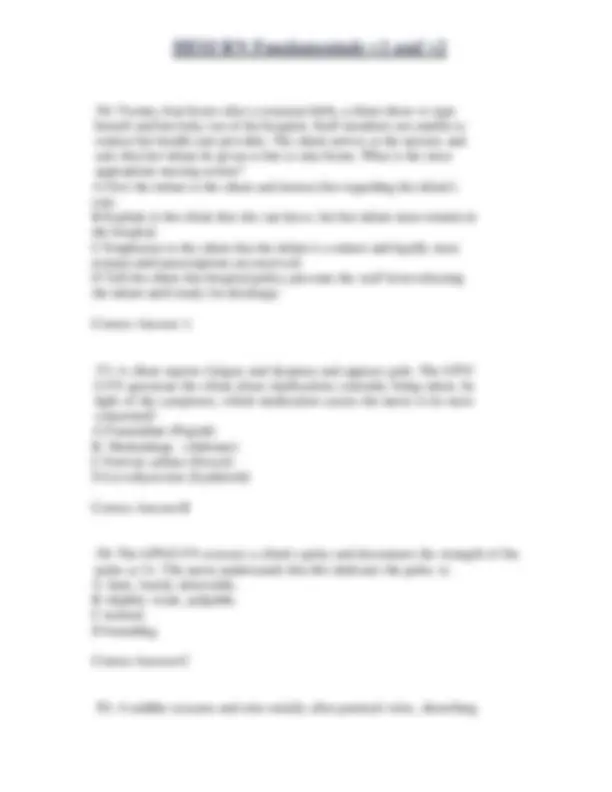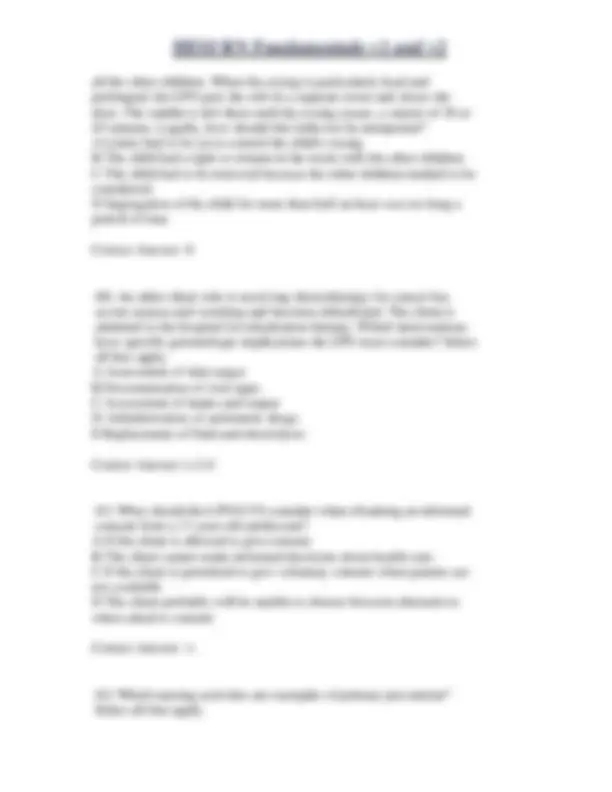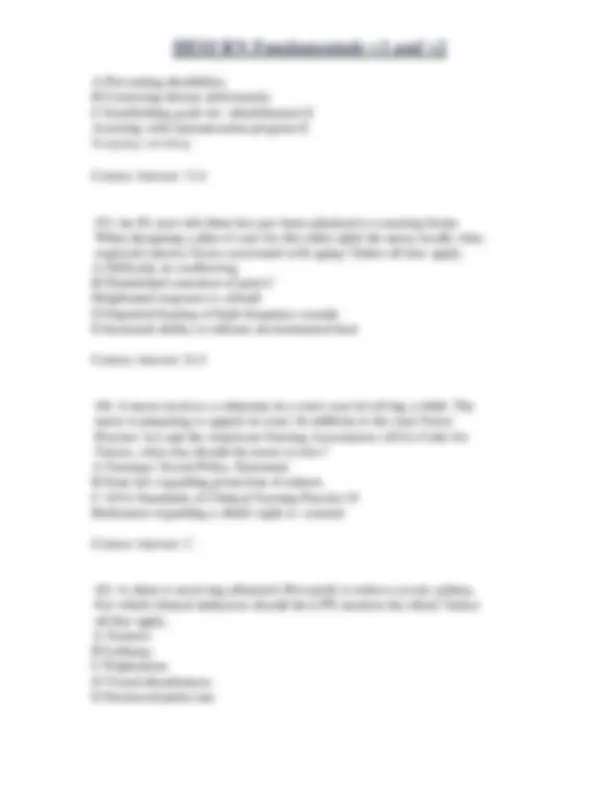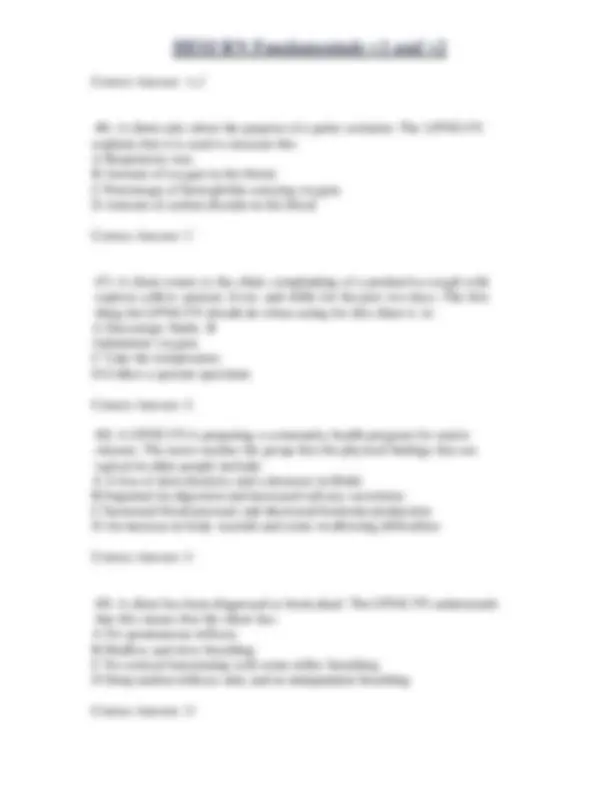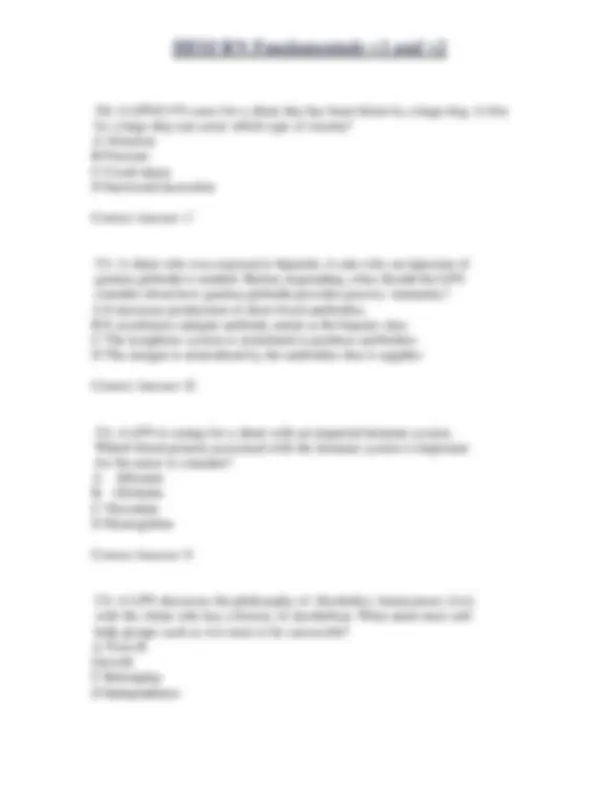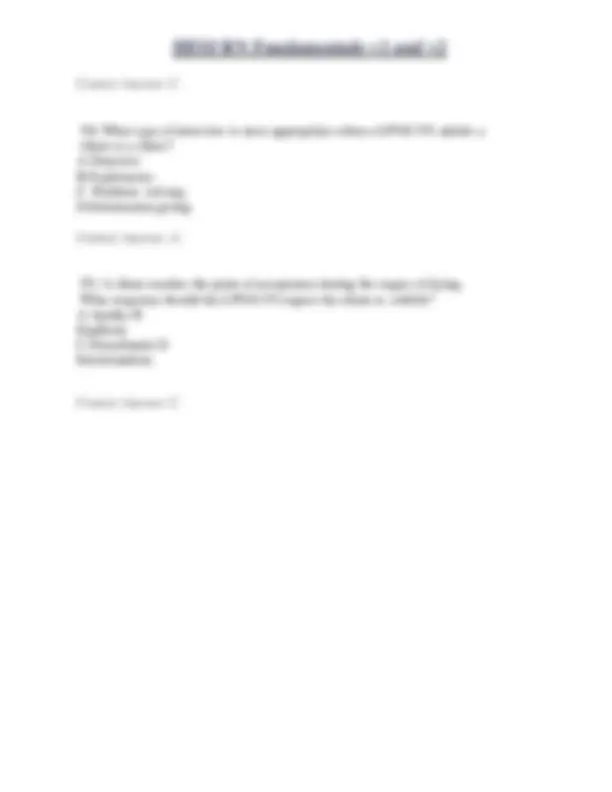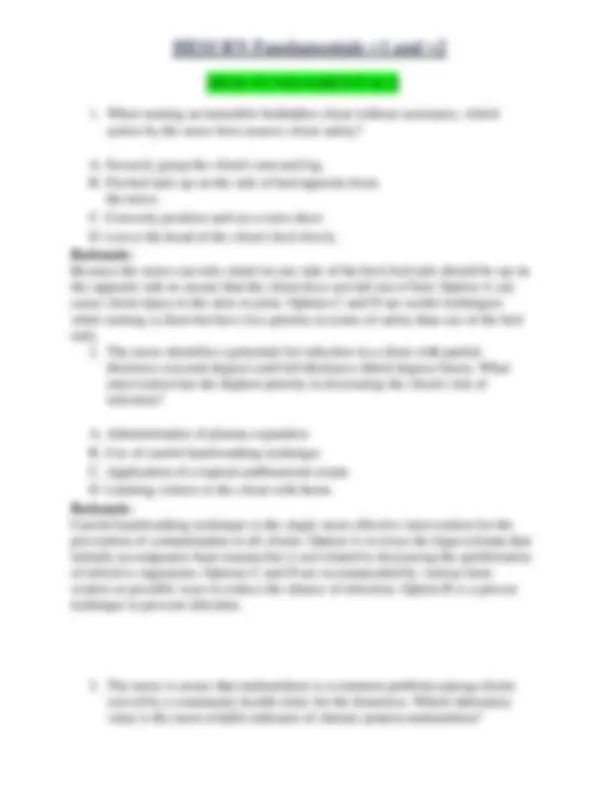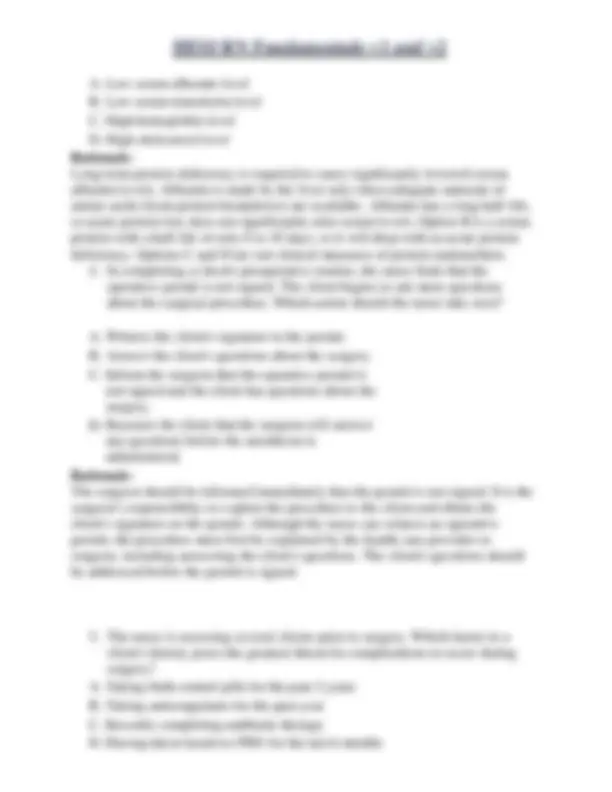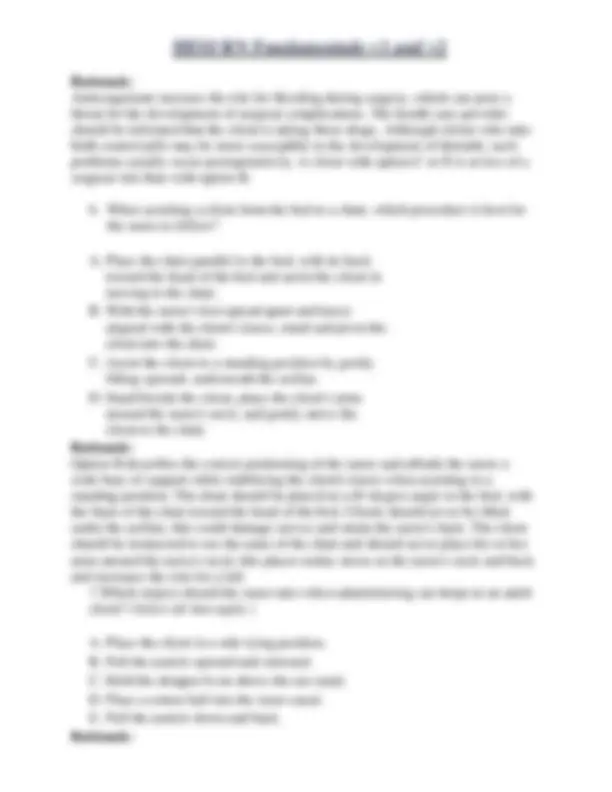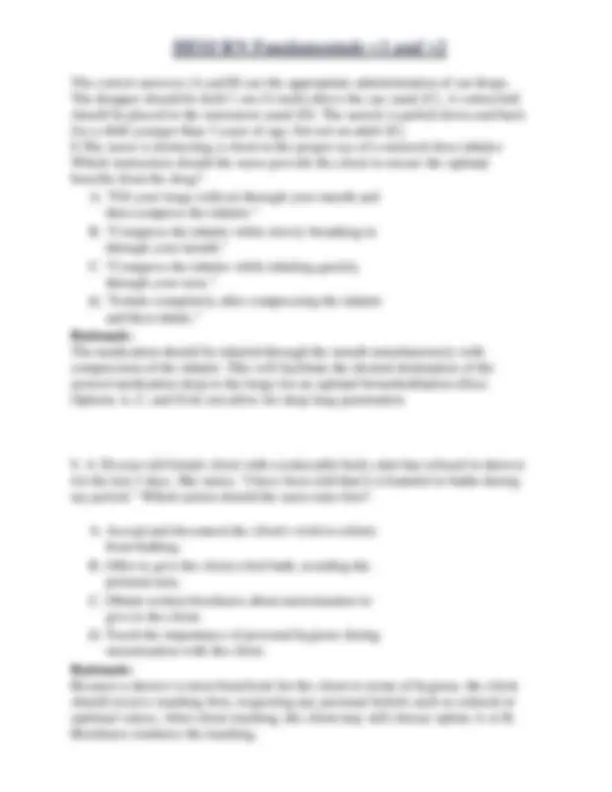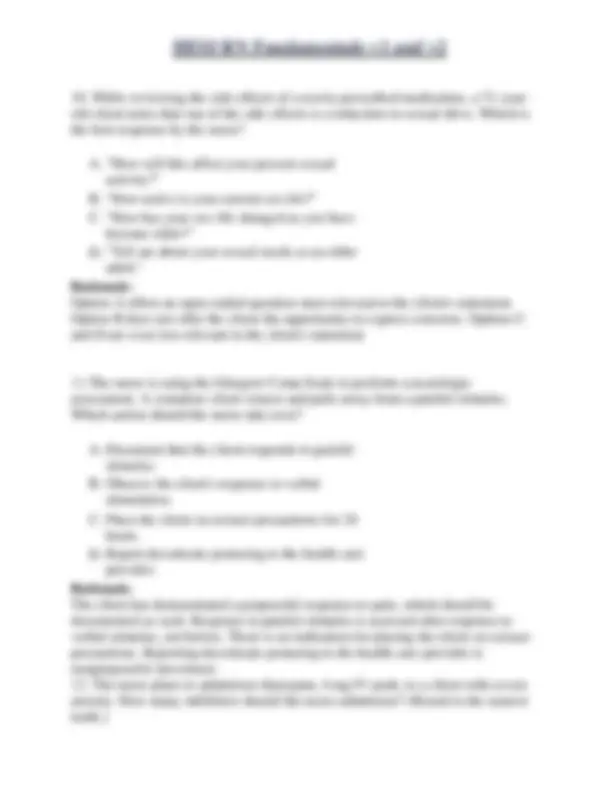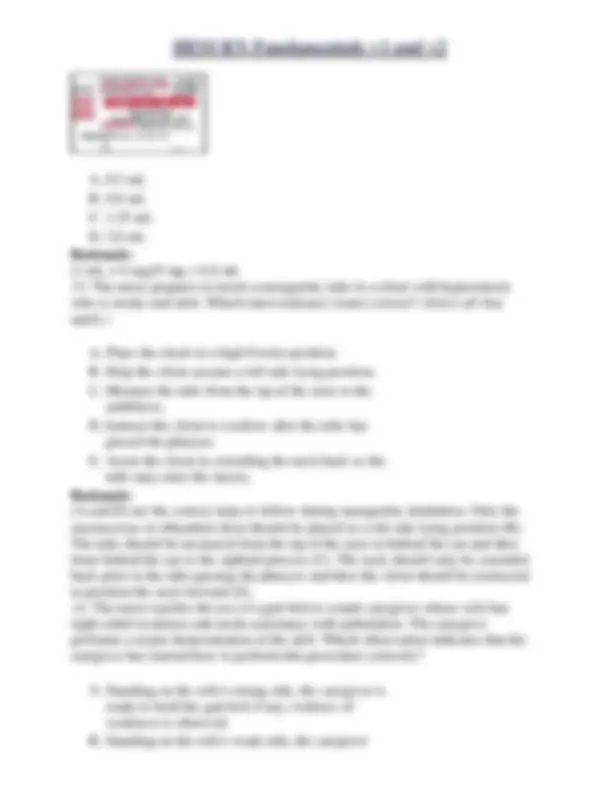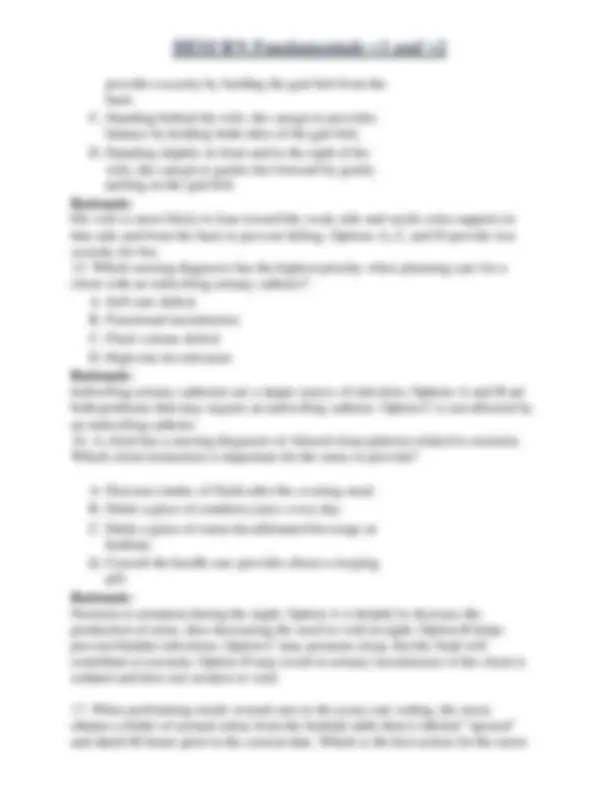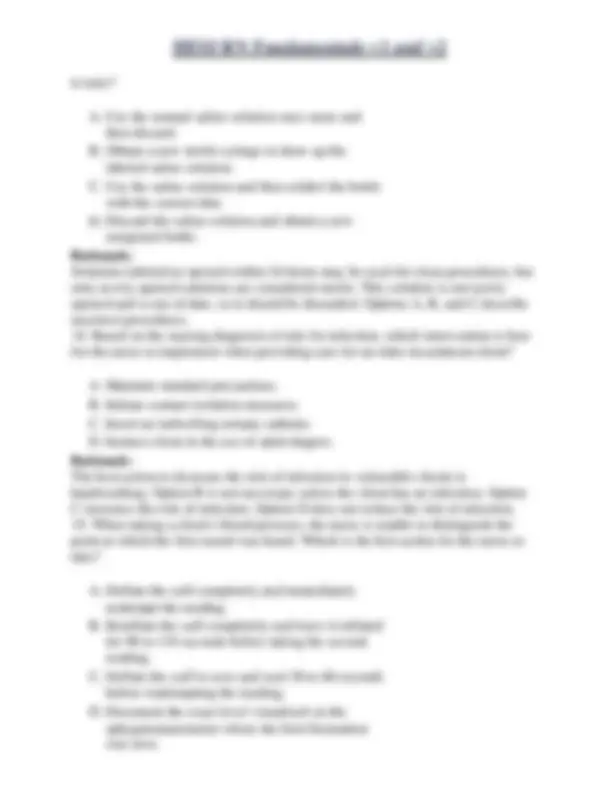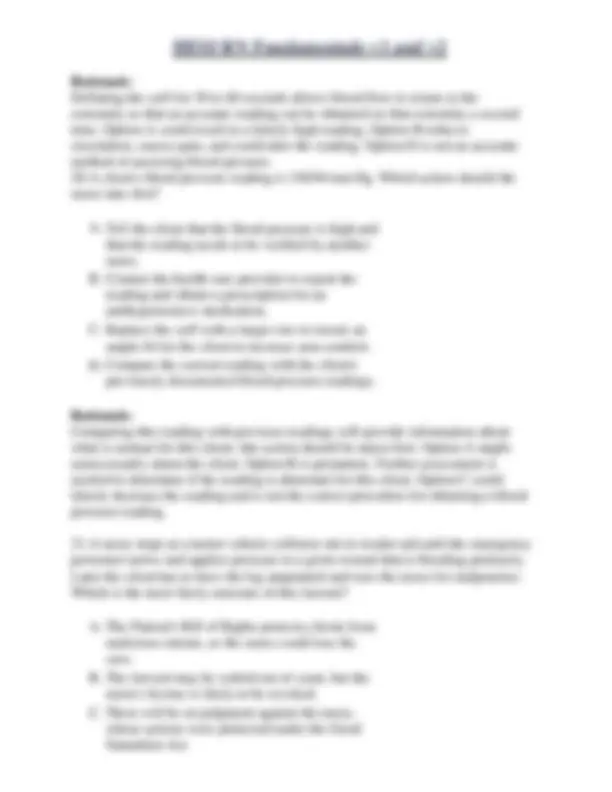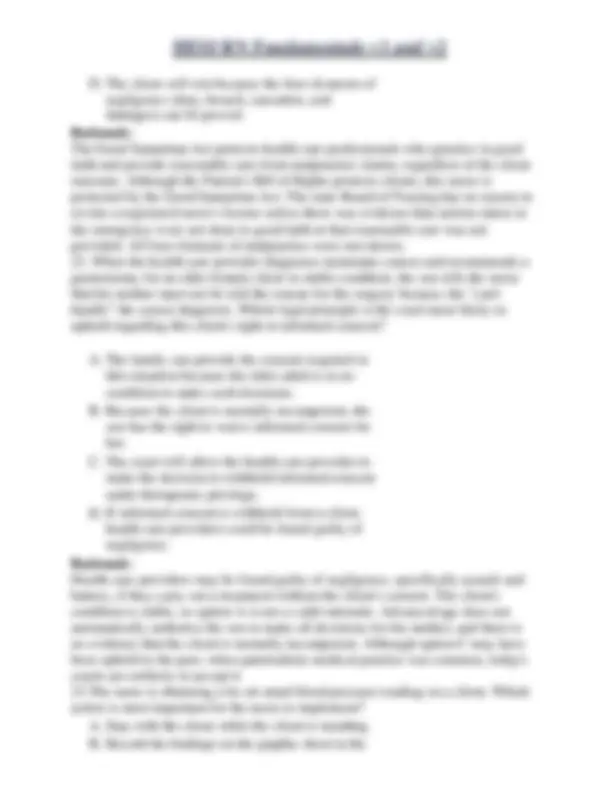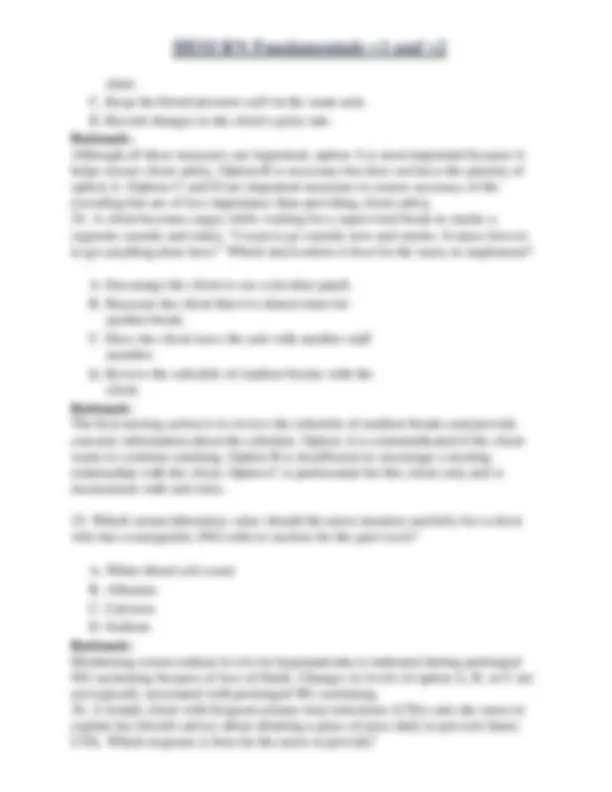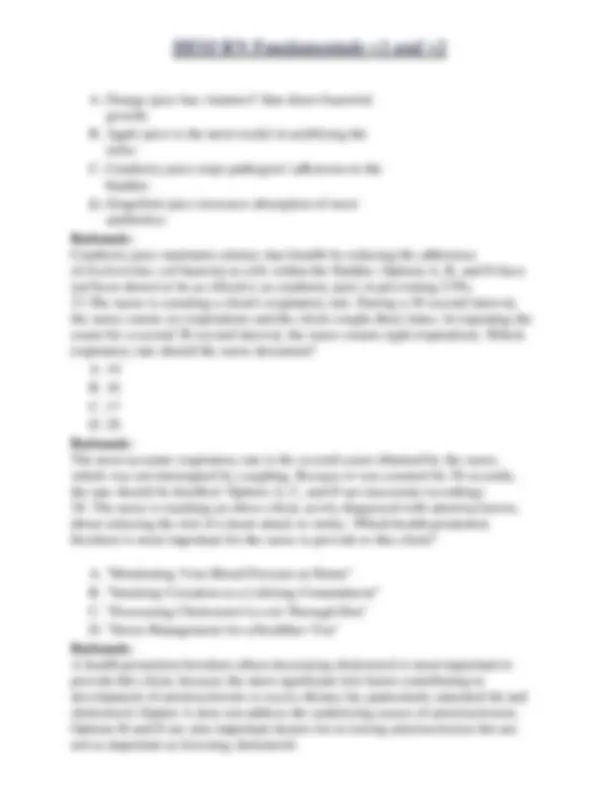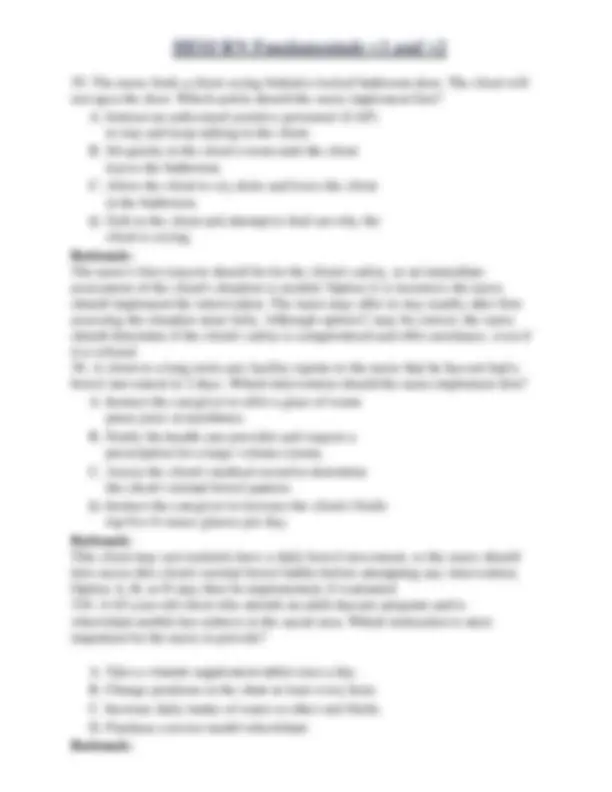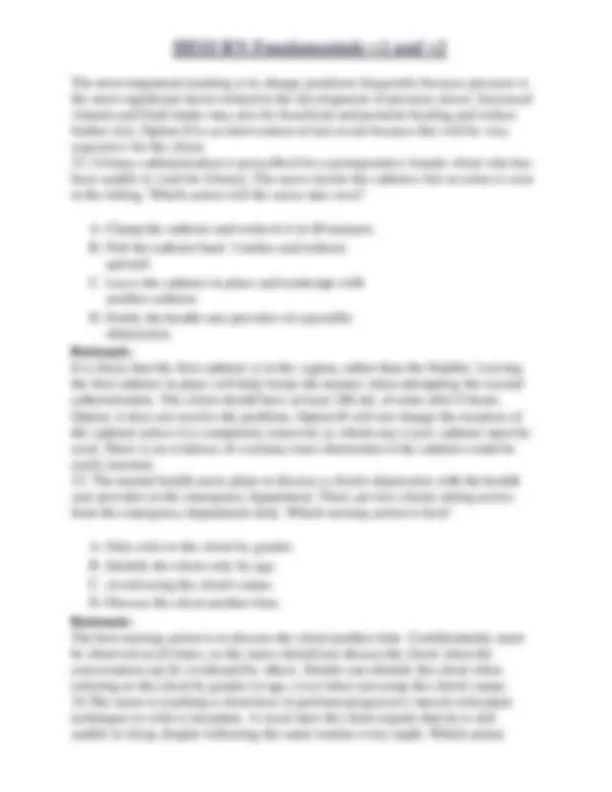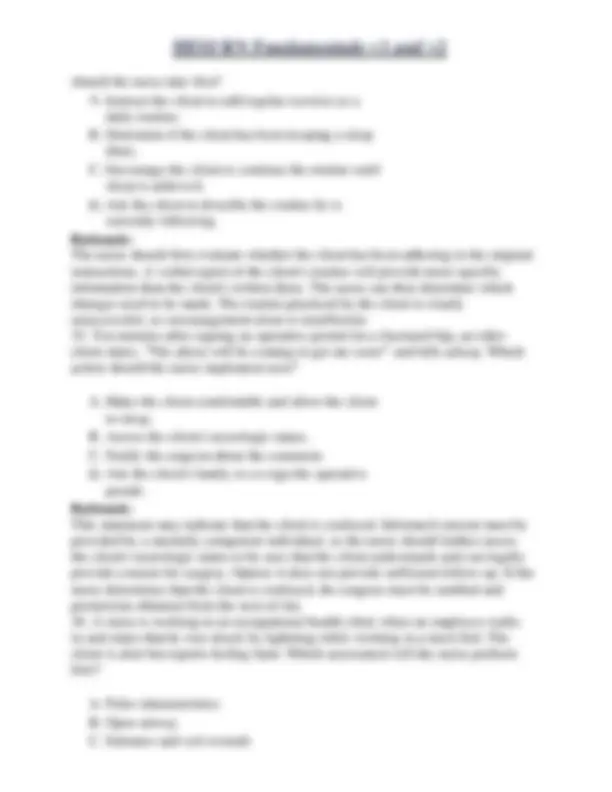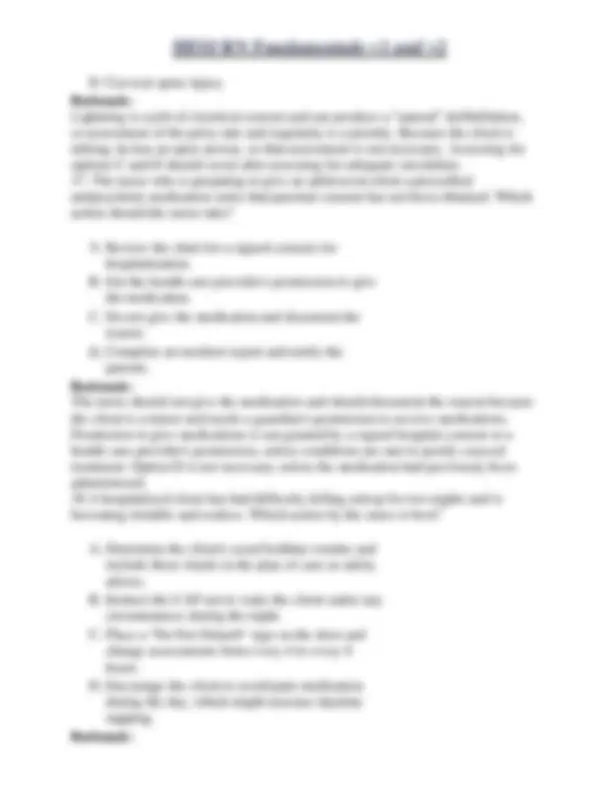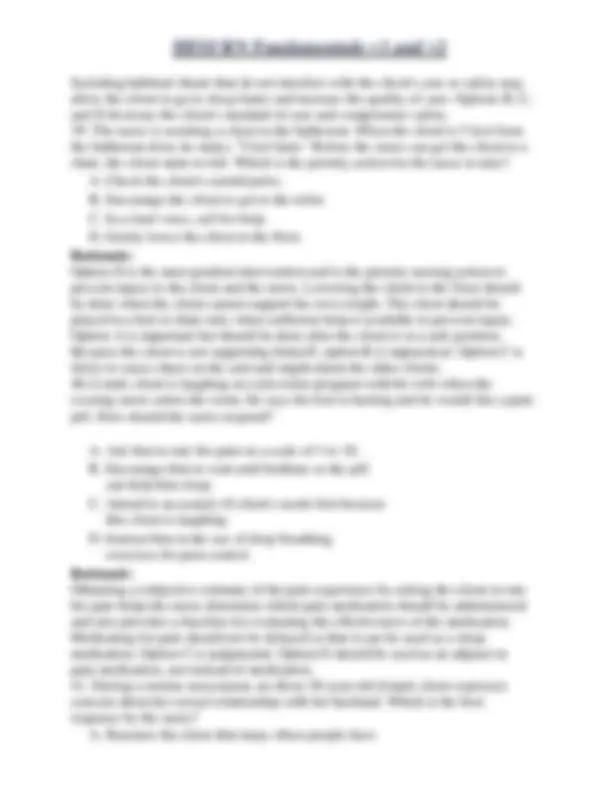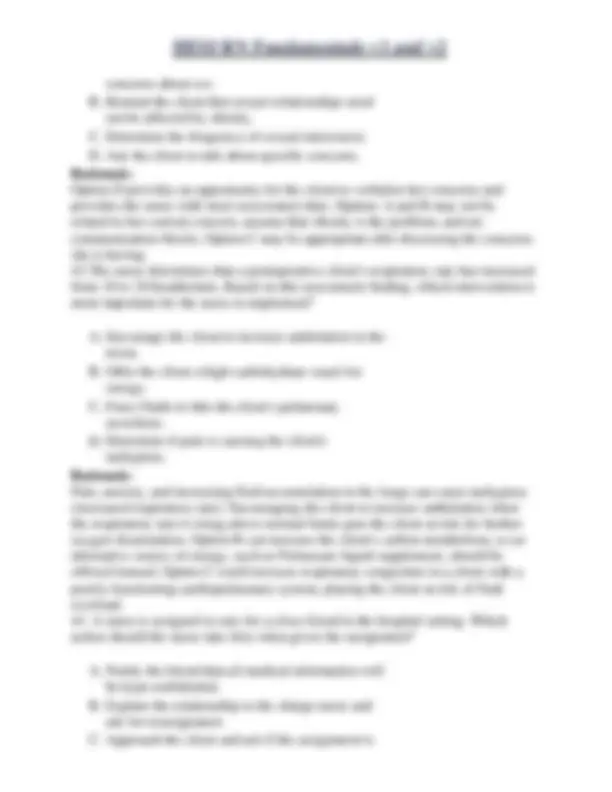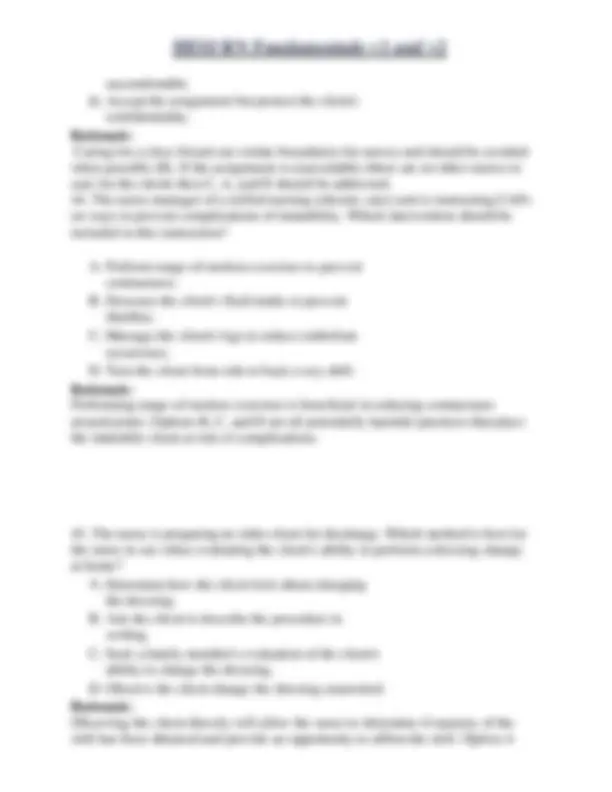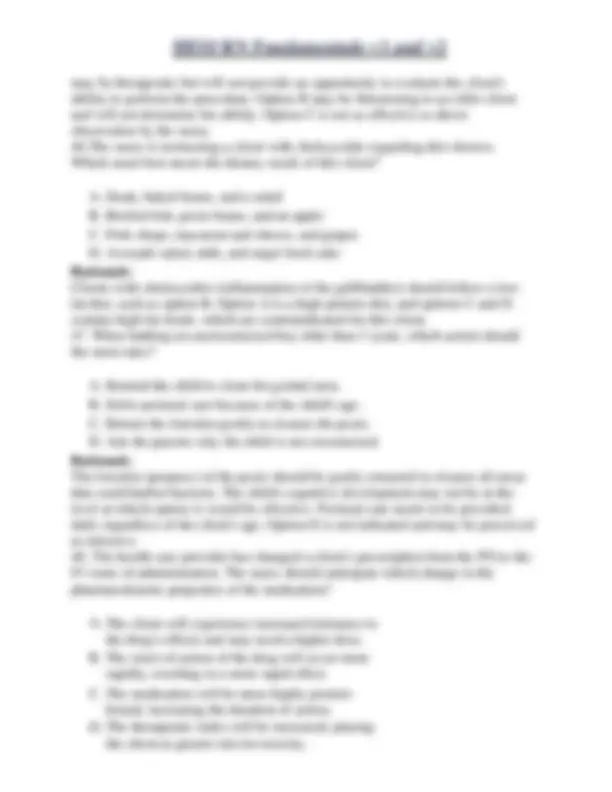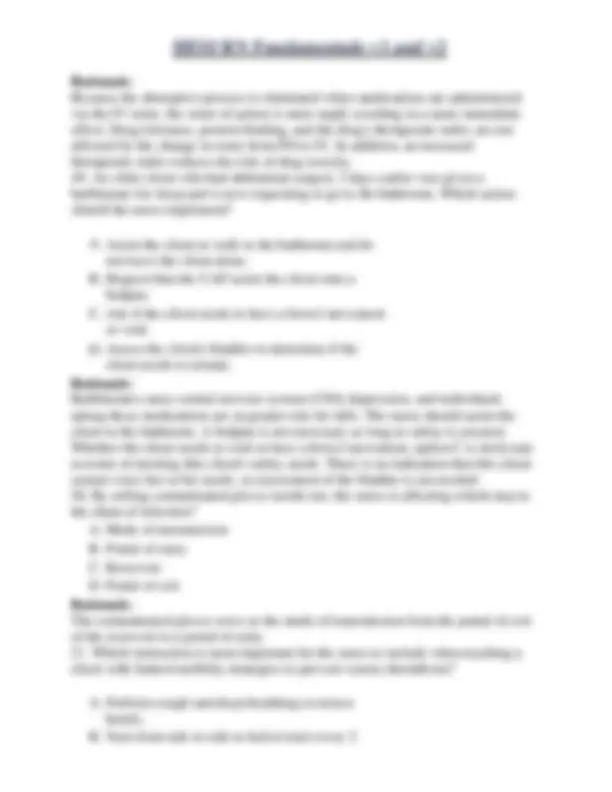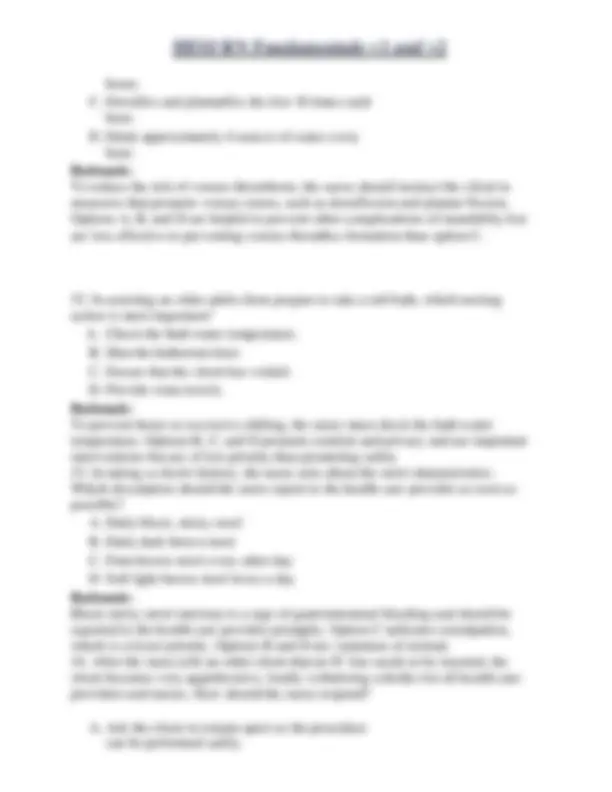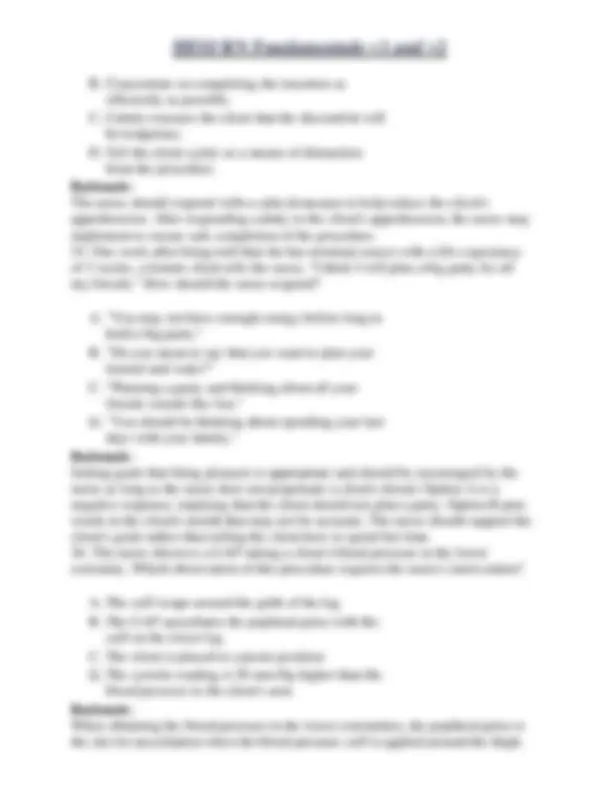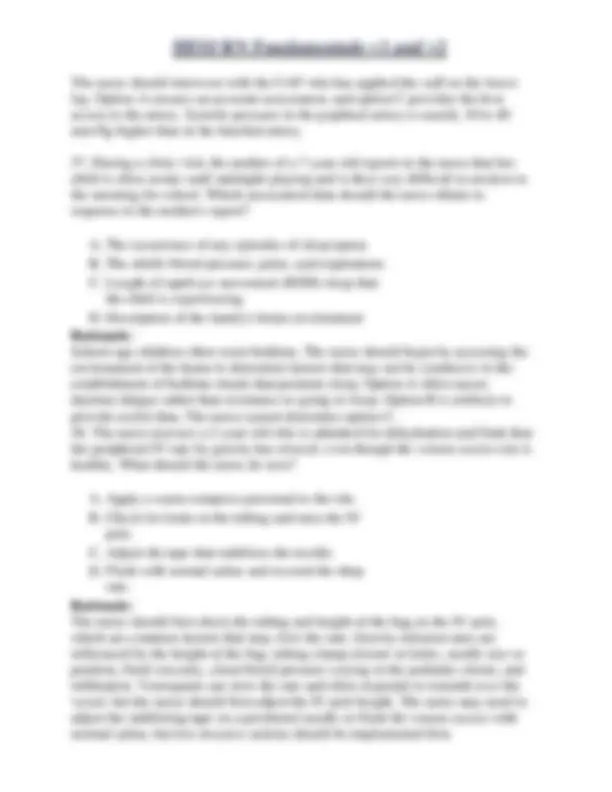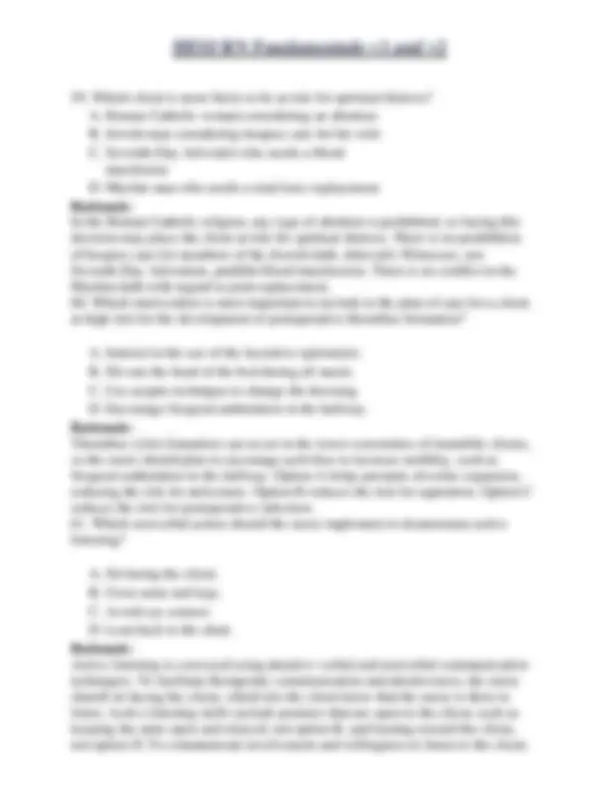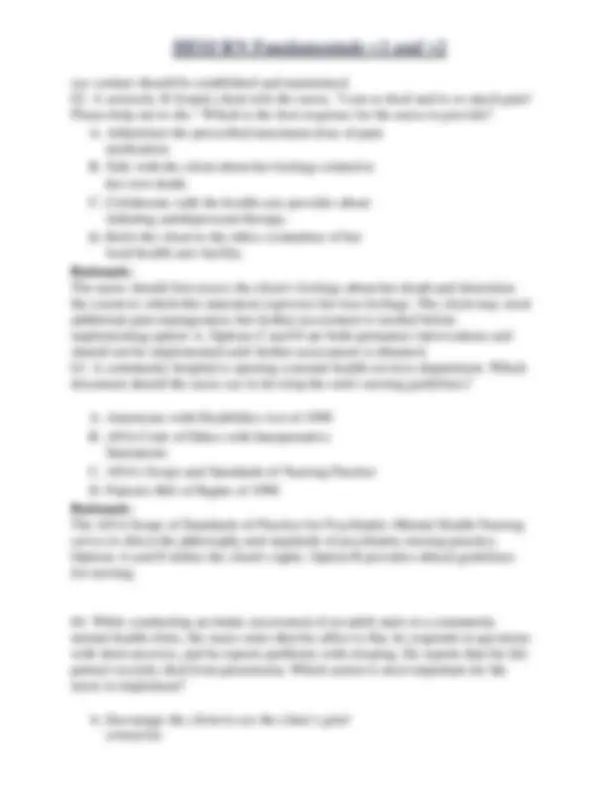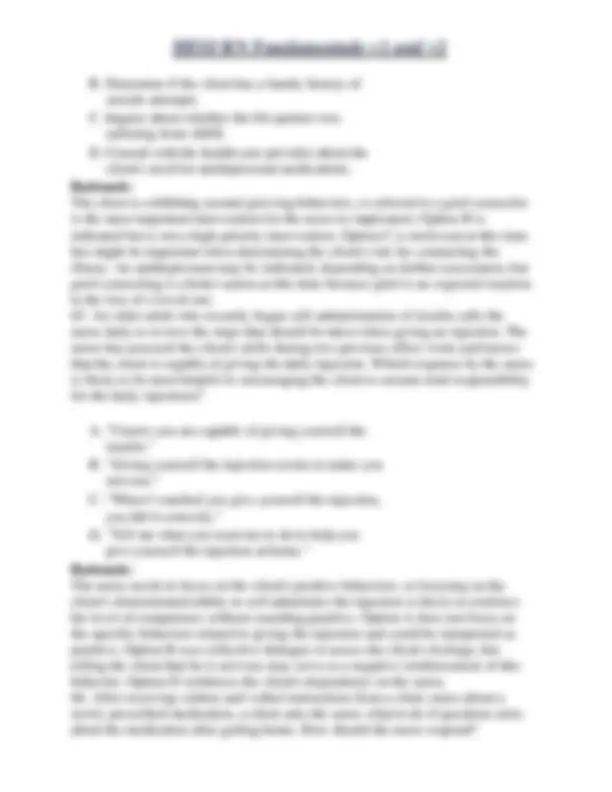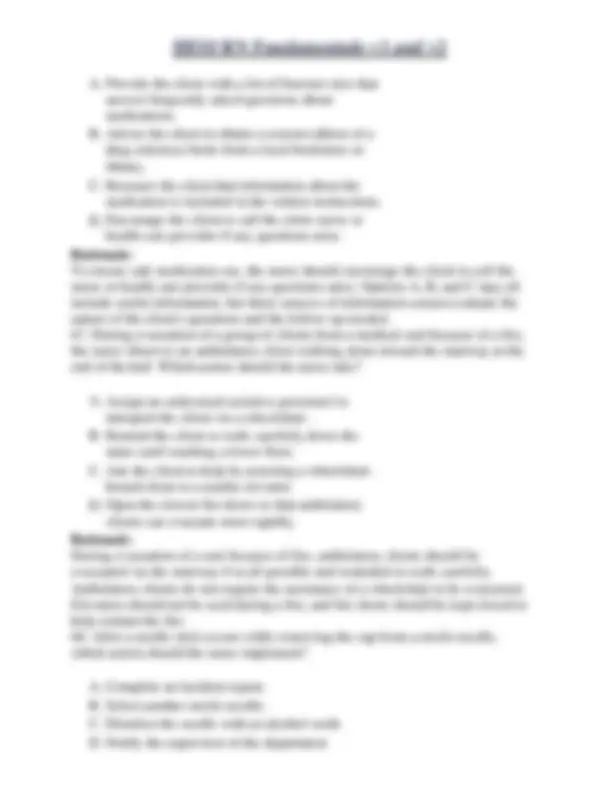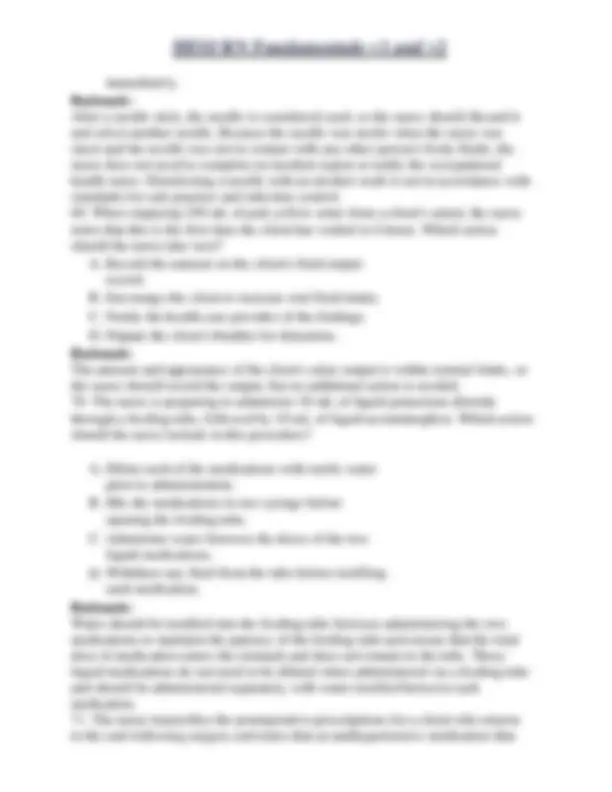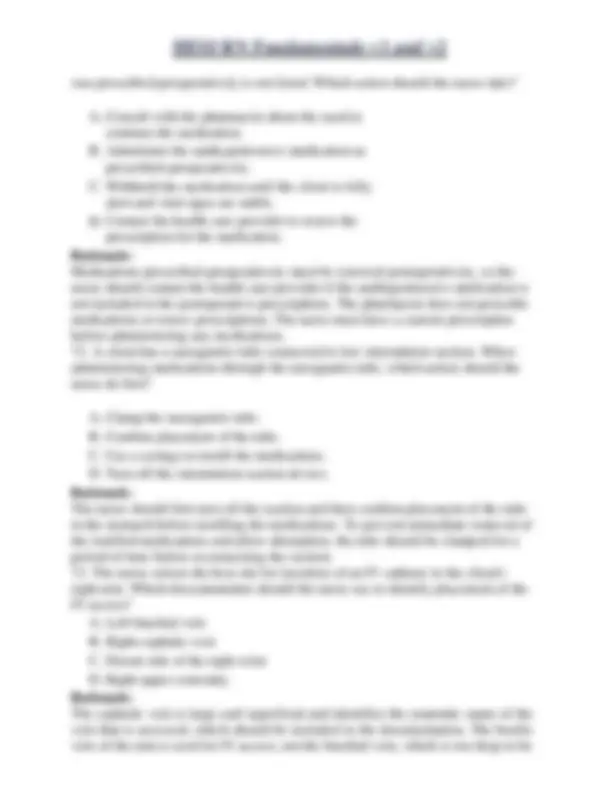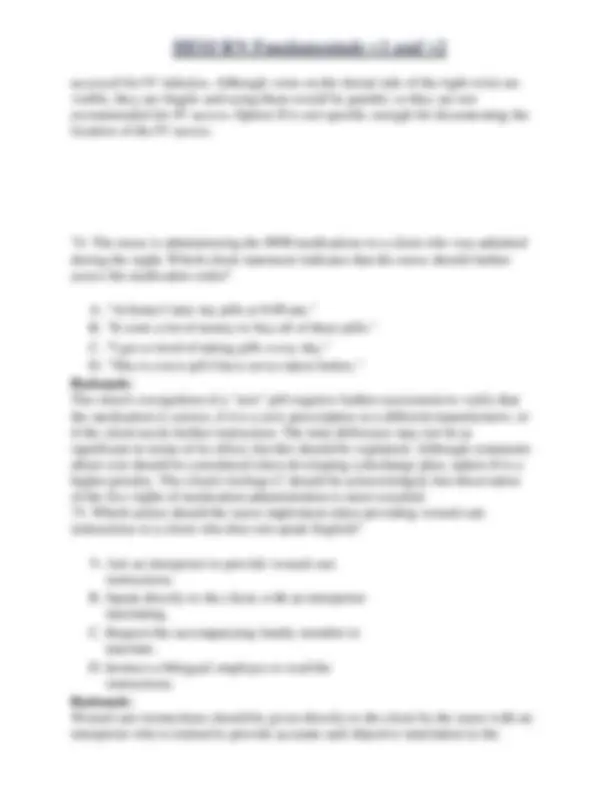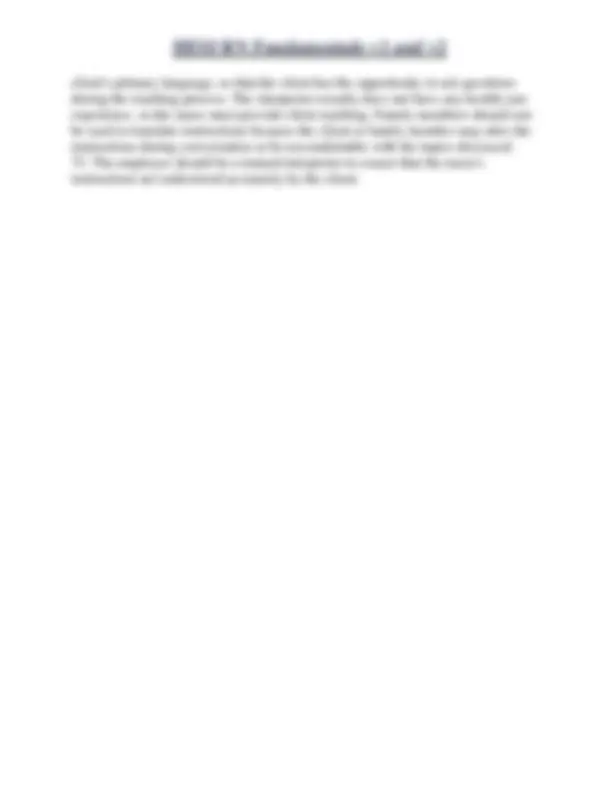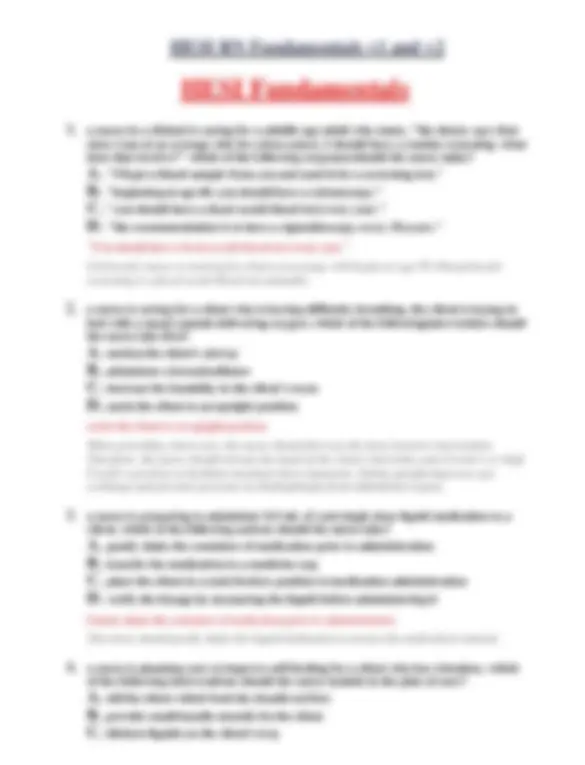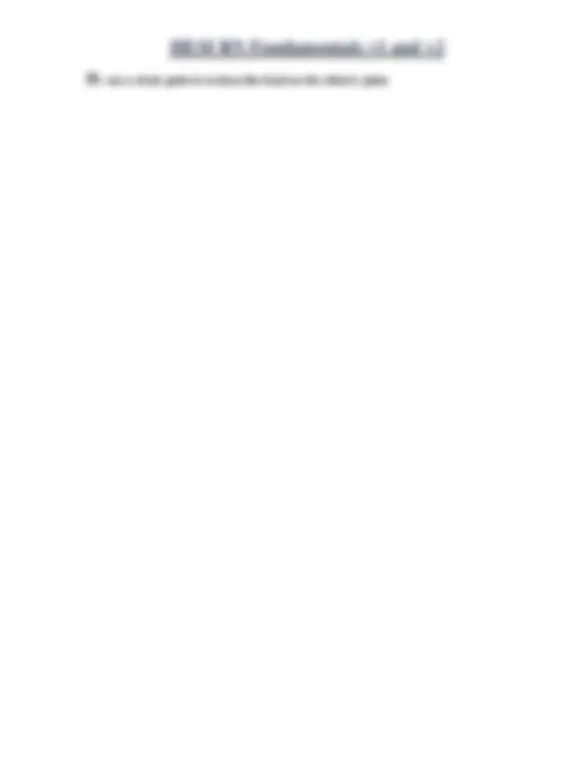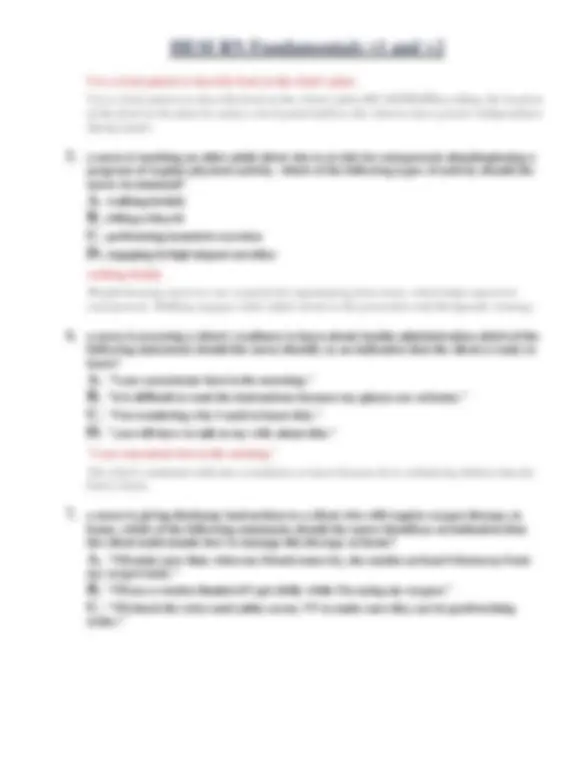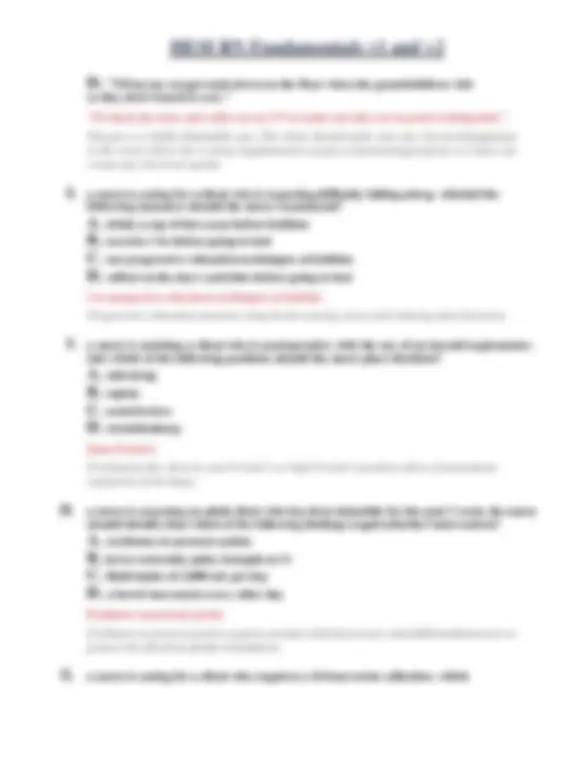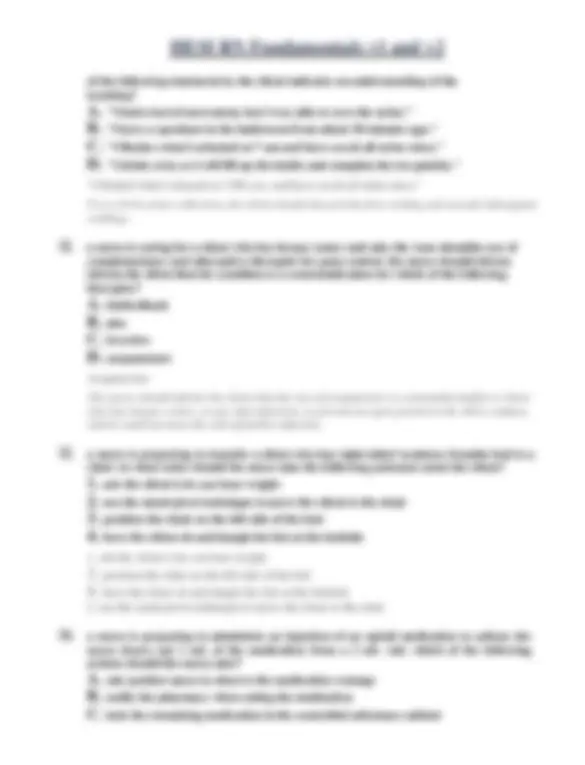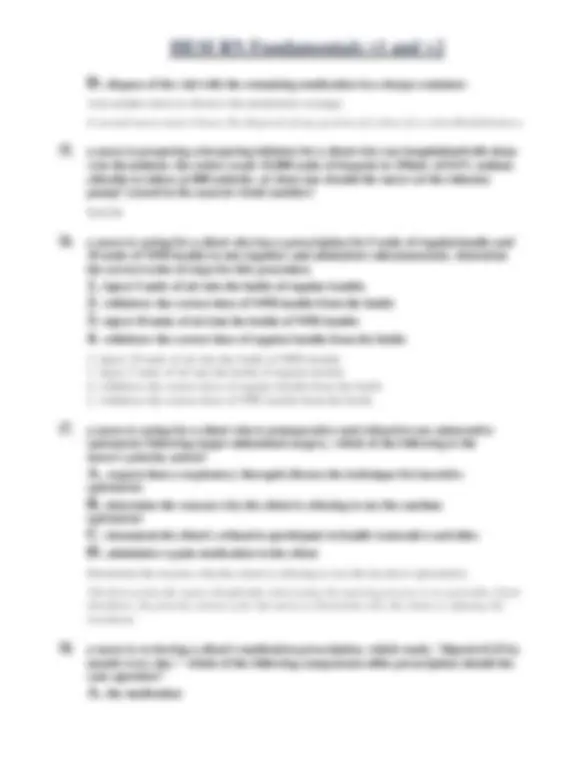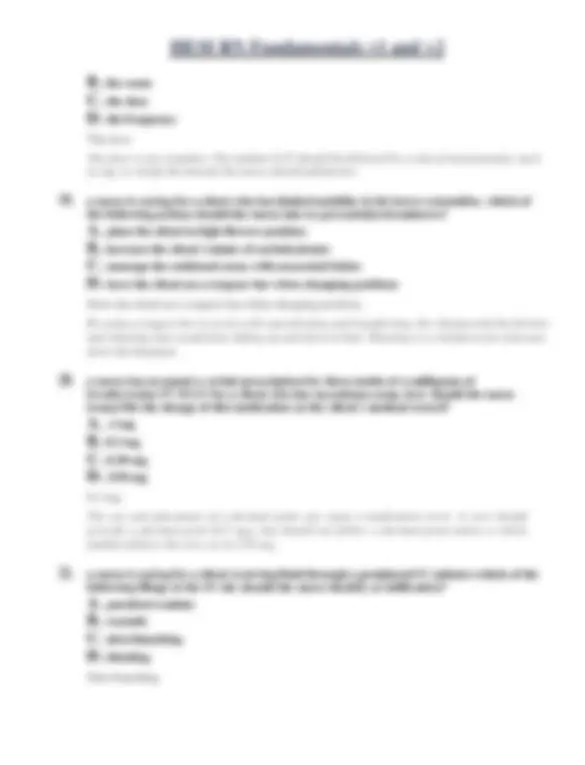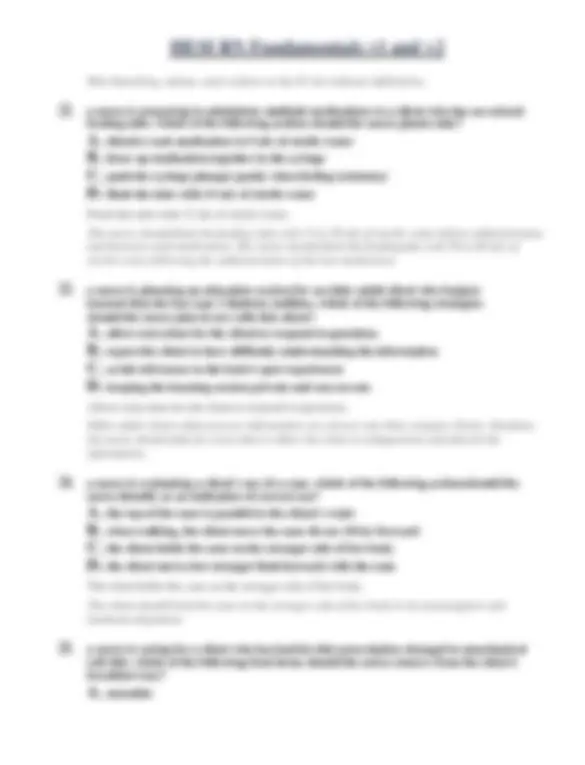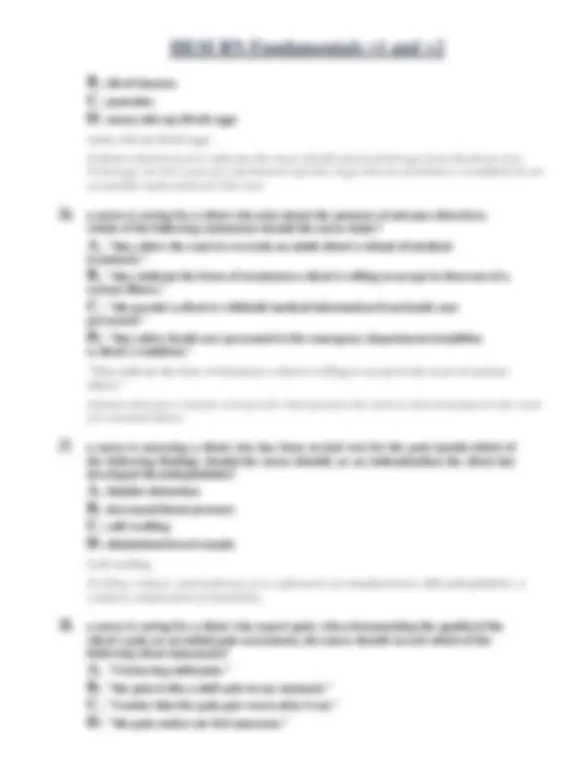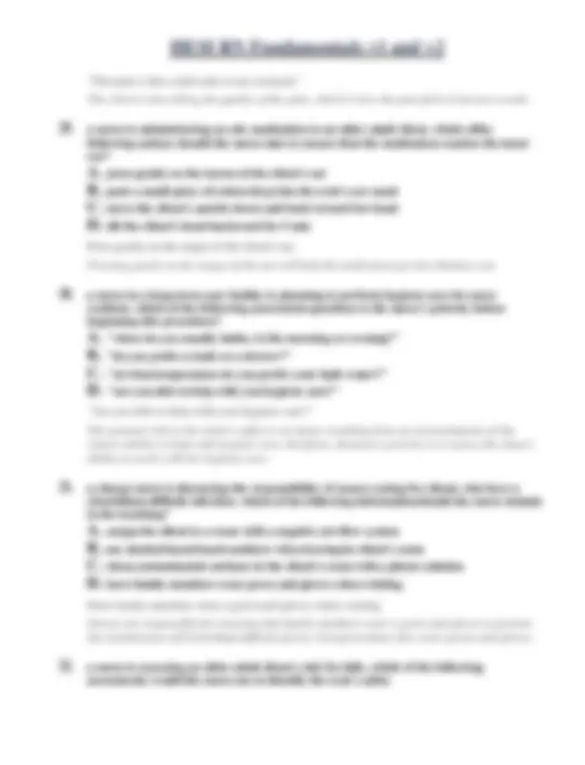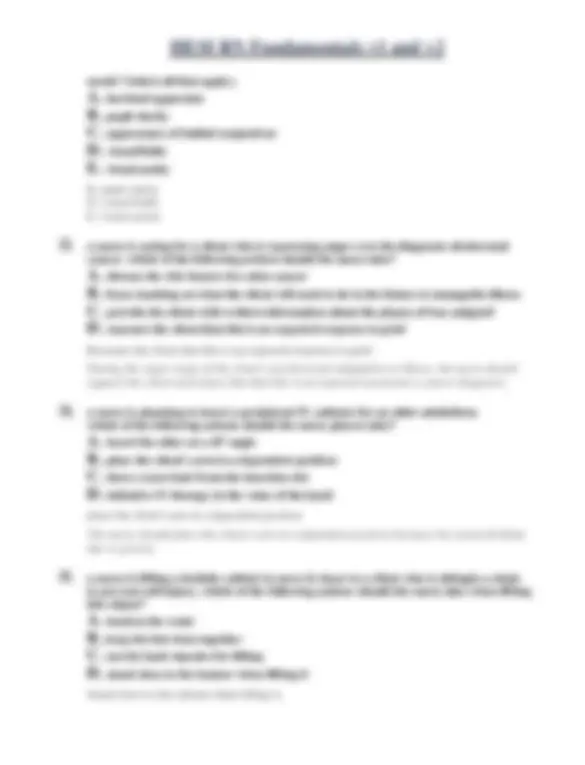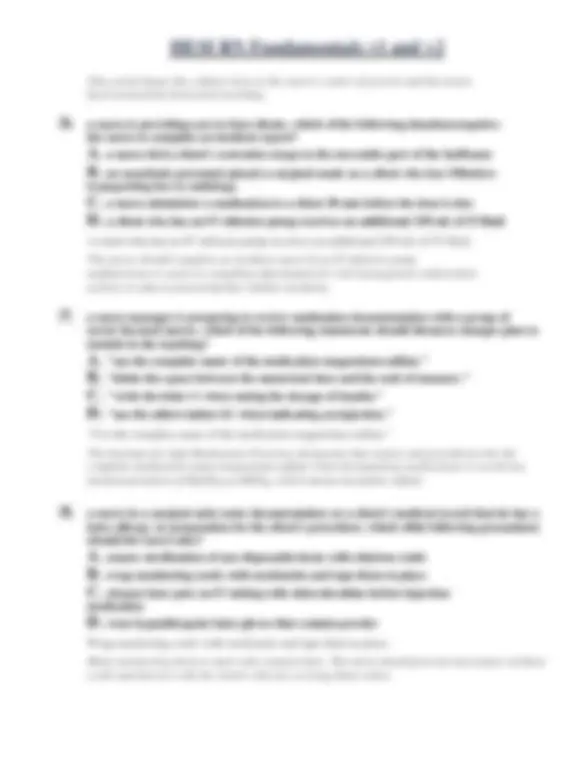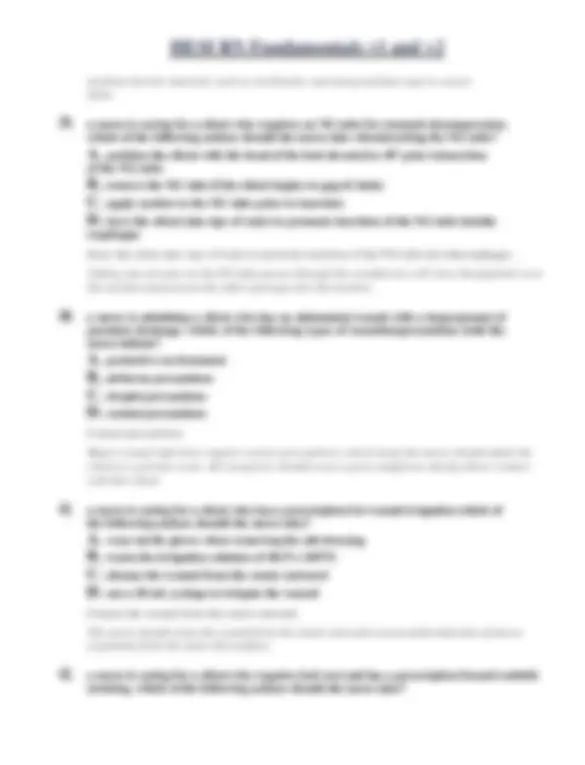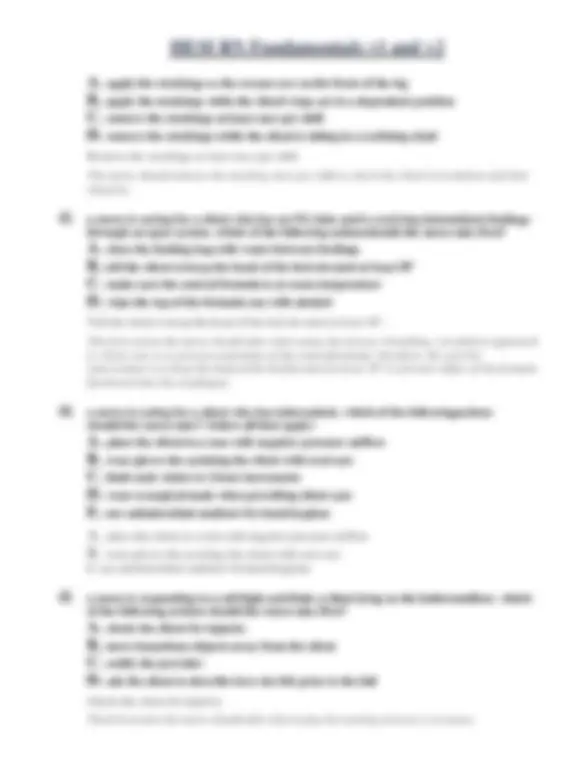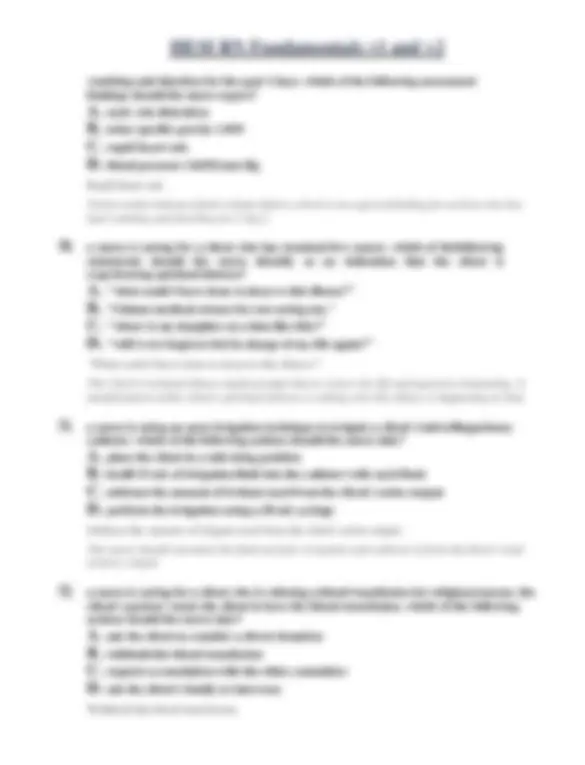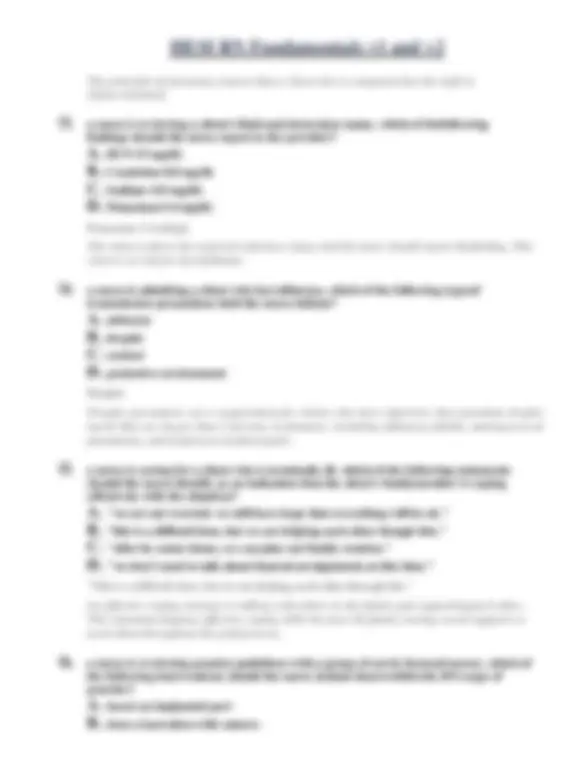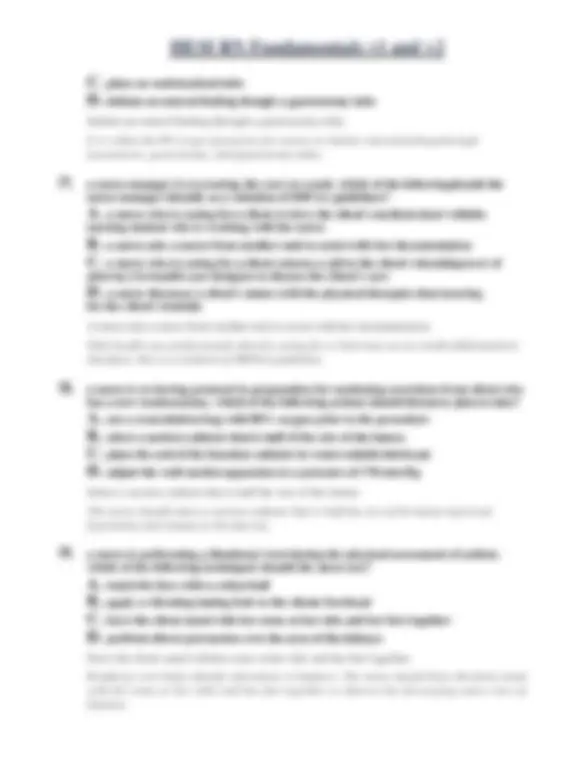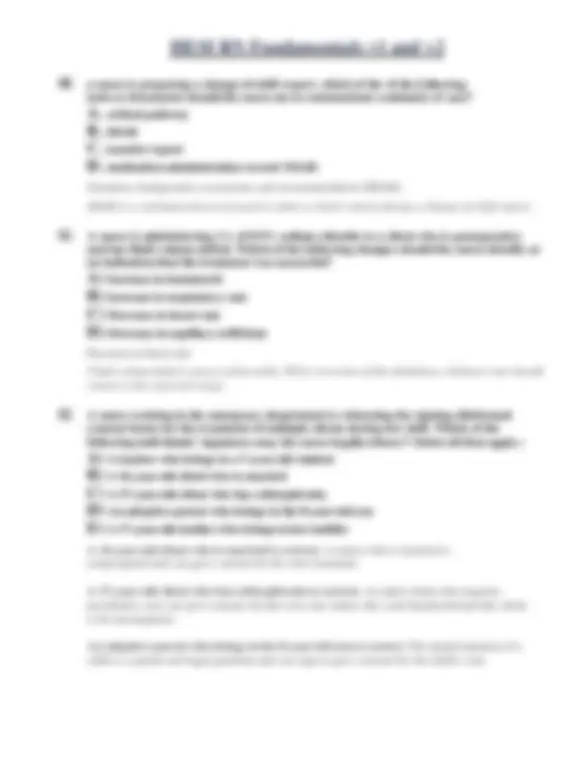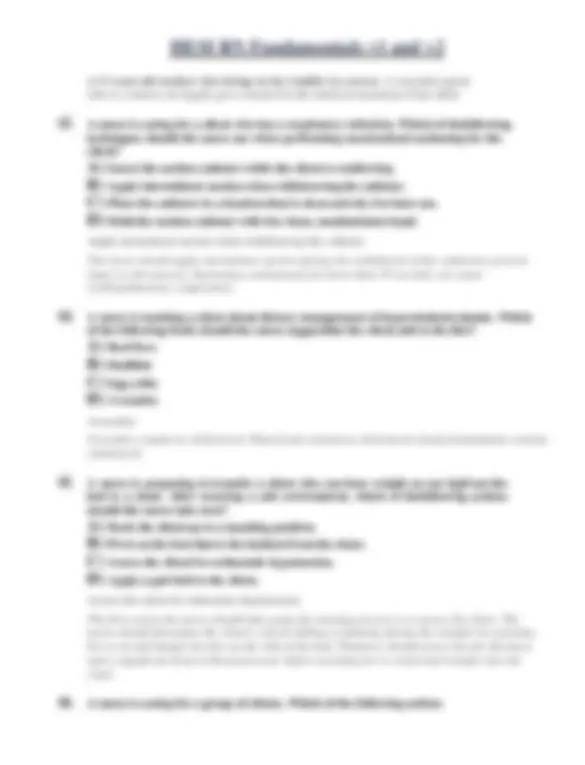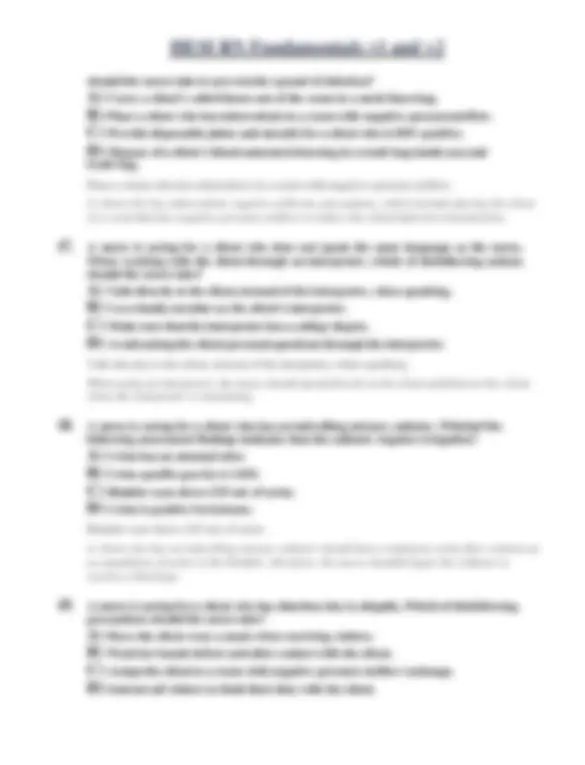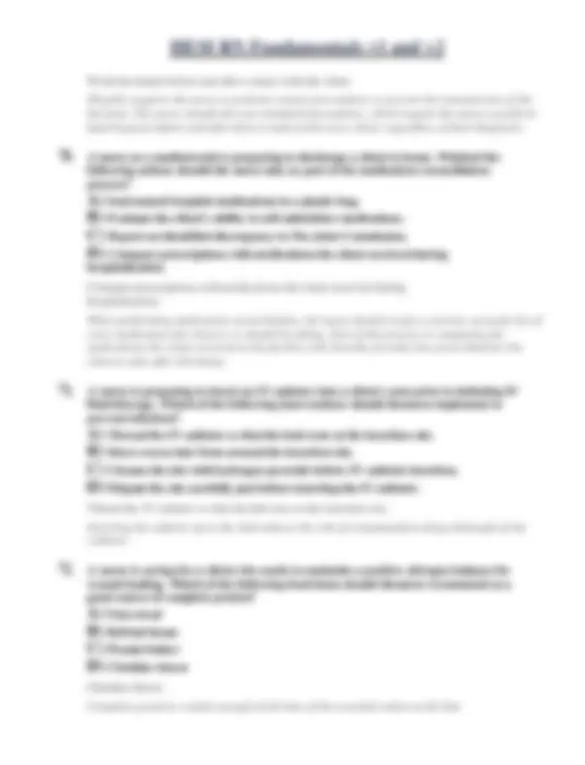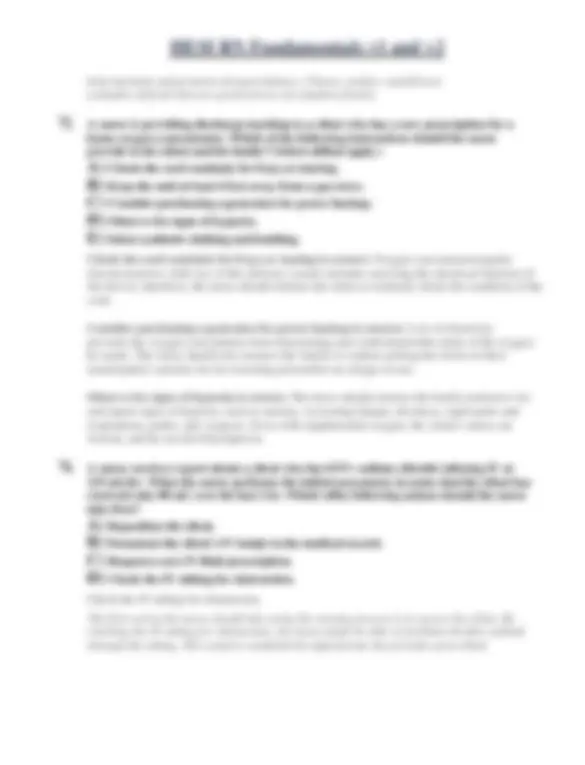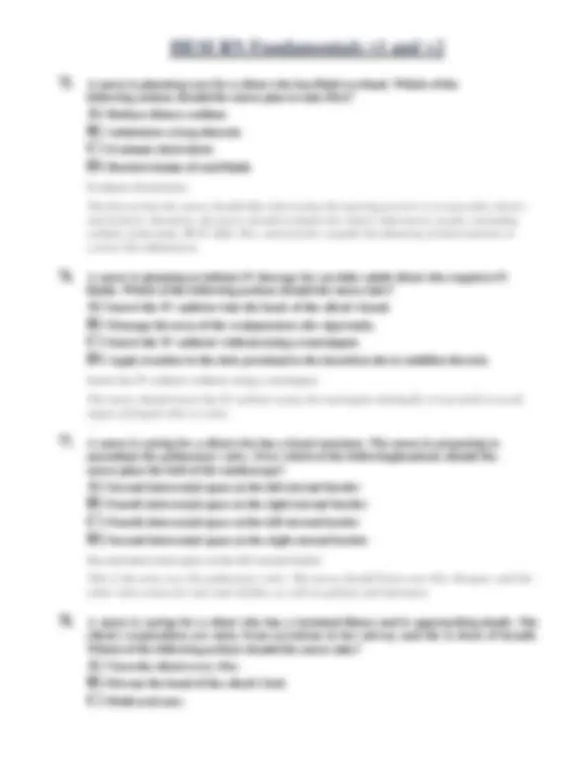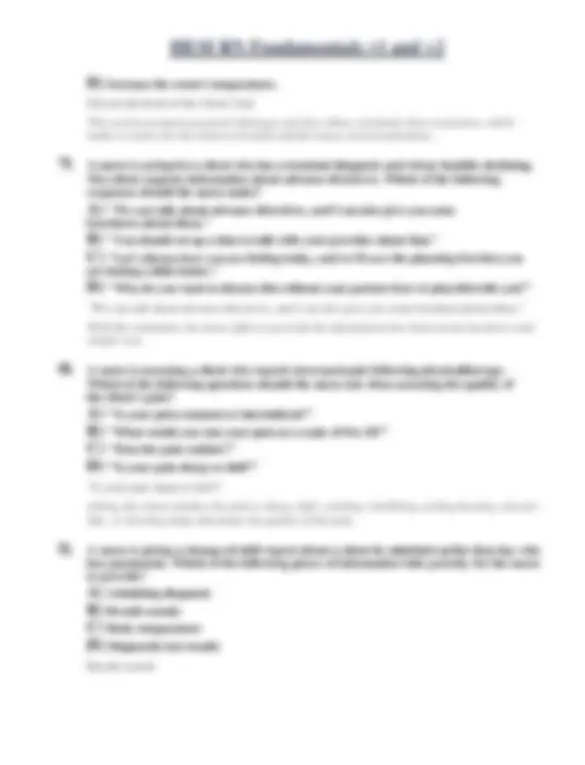Download Hesi rn fundamentals v1 and v2.pdf and more Exams Nursing in PDF only on Docsity!
HESI RN Fundamentals
12 Latest Versions
Verified Questions and Answers
Best Document for Exam Preparation
100 % Satisfaction Guaranteed
Complete and Latest Guide
For
HESI Fundamentals Exam
HESI FUNDAMENTALS
- A policy requiring the removal of acrylic nails by all nursing personnel was implemented 6 months ago. Which assessment measure best determines if the intended outcome of the policy is being achieved. a. Number of staff induced injury b. Client satisfaction survey c. Health care-associated infectionrate. d. Rate of needle-stick injuries bynurse.
- The nurse is preparing to assist a newly admitted client with personal hygiene measures. The client...the client’s gag reflex. Which action should the nurse include? A. Offer smalls sips of water through astraw B. Place tongue blade on back half oftongue C. Use a penlight to observe back of oral cavity D. Auscultate breath sounds after client swallows
- The nurse explains to an older adult male the procedure for collecting a 24-hour urine specimen for creatinine clearance. A. Assess the client for confusion and reteach the procedure B. Check the urine for color and texture C. Empty the urinal contents into the 24-hour collection container D. Discard the contents of the urinal
- A 54-year-old male client and his wife were informed this morning that he has terminal cancer. Which nursing intervention is likely to be most A. Ask her how she would like to participate in the client’s care B. Provide the wife with information about hospice C. Encourage the wife to visit after painful treatments are completed D. Refer her to support group for family members of those dying of cancer
- A client who has a body mass index (BMI) of 30 is requesting information on the initial approach to a weight loss plan. Which action should the nurse recommend? A. Plan low carbohydrate and high proteinmeals B. Engage in strenuous activity for an hourdaily C. Keep a record of food and drinks consumed daily D. Participated in a group exercise class 3 times a week
- The nurse assesses a client who has a nasal cannula delivering oxygen at 2 L/min. To assess for skin damage related to the cannula, which areas should the nurse observe? A. Tops of the ear B. Bridge of the nose C. Around the nostrils D. Over the cheeks E. Across the forehead
- The nurse observes an unlicensed assistive personnel (UAP) who is providing a total bed bath for a confused and lethargic client. The UAP is soaking the client’s foot in a basin of warm water placed on the bed. What action should the nurse take? a. Remove the basin of water from the client’s bed immediately b. Remind the UAP to dry between the client’s toes completely c. Advise the UAP that this procedure is damaging to the skin d. Add skin cream to the basin of water while the foot is soaking
- The nurse in the emergency department observes a colleague viewing the electronic health record (EHR) of a client who holds an elected position in the community. The client is not a part of the colleague’s assignment. Which action should the nurseimplement? a. Communicate the colleague’s actions to the unit charge nurse b. Send an email to facility administration reporting the action c. Write an anonymous complaint to a professional website d. Post a comment about the action on a staff discussion board
- At 0100 on a male client’s second postoperative night, the client states he is unstable to sleep and plans to read until feeling sleepy. What action should the nurse implement? a. Leave the room and close the door to the client’s room b. Assess the appearance of the client’s surgical dressing c. Bring the client a prescribed PRN sedative-hypnotic d. Discuss symptoms of sleep deprivation with the client
- The nursing staff in the cardiovascular intensive care unit are creating a continuous quality improvement project on social media that addresses coronary artery disease (CAD). Which action should the nurse implement to protect client privacy? a. Remove identifying information of the clients who participated b. Recall that authored content may be legally discoverable c. Share material from credible, peer reviewed sources only d. Respect all copyright laws when adding website content
- A male client with unstable angina needs a cardiac catheterization, so the healthcare provider explains the risks and benefits of the procedure, and then leaves to set up for the procedure. When the nurse presents the consent form for signature, the client hesitates and asks how the wires will keep his heart going. Which action should the nurse take? a. Answer the client’s specific questions with a short understandable explanation b. Postpone the procedure until the client understands the risks and benefits c. Call the client’s next of kin and ask them to provide verbal consent d. Page the healthcare provider to return and provide additional explanation
- The nurse is teaching a client how to do active range of motion (ROM) exercises. To exercise the hinge joints, which action should the nurse instruct the client to perform? a. Tilt the pelvis forwards and backwards
back surgery for a herniated intervertebral disk, and reports that she has found
acupuncture effective in resolving past acute episodes. Which response is best for
the nurse to provide?
a. Surgery removes the disk and is the only treatment that can totally resolve the pain b. The medication regimen you previously used should be re-evaluated for dose adjustment c. Massage and hot pack treatments are less invasive and can provide temporary relief d. Acupuncture is a complementary therapy that is often effective for management of pain
- The nurse is providing wound care to a client with stage 3 pressure ulcer that has a large amount of eschar. The wound care prescription states “clean the wound and then apply collagenase.” collagenase is a debriding agent. The prescription does not specify a cleaning method. Which technique should the nurse cleanse the pressure ulcer? a. Lightly coat the wound with povidone-iodine solution b. Irrigate the wound with sterile normal saline c. Flush the wound with sterile hydrogen peroxide d. Remove the eschar with a wet-to-dry dressing
- A client is admitted with a fever of unknown origin. To assess fever patterns, which intervention should the nurse implement? a. Document the client’s circadian rhythms b. Assess for flushed, warm skin regularly c. Measure temperature at regularintervals d. Vary sites for temperature measurement
- When performing blood pressure measurement to assess for orthostatic hypotension, which action should the nurse implement first? a. Position the client supine for a few minutes b. Assist the client to stand at thebedside c. Apply the blood pressure cuffsecurely d. Record the client’s pulse rate and rhythm
- The nurse retrieves hydromorphone 4mg/mL from the Pyxis MedStation, an automated dispensing system, for a client who is receiving hydromorphone 3 mg IM 6 hours PRN severe pain. How many mL should the nurse administer to the client? (Enter the numerical value only. If rounding is required , round to the nearest tenth) Ans: 0.
- The unlicensed assistive personnel (UAP) describes the appearance of the bowel movement of several clients. Which description warrants additional follow up by the nurse? (select all that applies).
a. Solid with red
streaks.
b. Brown liquid.
c. Multiple hard pellets.
d. Formed but
soft.
e. e. Tarry
appearance.
- A female UAP is assigned to take the vital signs of a client with pertussis for whom droplet precautions have been implemented. The UAP requests a change in assignment...she has not yet been fitted for a particulate filter mask.Which action should the nurse take? a. Advise the UAP to wear a standard face mask to take vital signs, and then get fitted for a filter mask before providing personal care b. Send the UAP to be fitted for a particulate filter mask immediately so she can provide care to this client c. Instruct the UAP that a standard mask is sufficient for the provision of care for the assigned client d. Before changing assignments, determine which staff members have fitted particulate filter masks
- In-home hospice care is arranged for a client with stage 4 lung cancer. While the palliative nurse is arranging for discharge, the client verbalizes concerns about pain. What action should the nurse implement? a. Explain the respiratory problems that can occur with morphine use. b. Teach family how to evaluate the effectiveness of analgesics. c. Recommend asking the healthcare professional for a patient-controlled analgesic (PCA) pump. d. Provide client with a schedule of around-the-clock prescribed analgesic use.
- What assessment finding places a client at risk for problems associated with impaired skin integrity? a. Scattered macula of the face b. Capillary refill 5 seconds c. Smooth nail texture d. Absence of skin tenting
- When evaluating the effectiveness of a client’s nursing care, the nurse first reviews the expected outcomes identified in the plan of care. What action should the nurse take next? a. Determine if the expected outcomes were realistic b. Obtain current client data to compare with expected outcomes c. Modify the nursing interventions to achieve the client’s goals d. Review related professional standards of care
- The nurse attaches a pulse oximeter to a client’s fingers and obtains an oxygen saturation reading of 91%. Which assessment finding most likely contributes to this reading? a. BP 142/88 mmHg b. 2+ edema of fingers and hands c. Radial pulse volume is + d. Capillary refill time is 2 seconds
- The nurse is caring for a hospitalized client who was placed in restraints due to confusion. The family removes the restraints while they are with the client. When the family leaves, what action should the nurse take first? a. Apply the restraints to maintain the client’s safety. b. Reassess the client to determine the need for continuing restraints.
c. Document the time the family left and continue to monitor the client. d. Call the healthcare provider for a new prescription.
c. Notify the healthcare provider d. Give the client 8 oz of water to drink
- The nurse is conducting an initial admission assessment for a woman who is Mexican-American and who is scheduled to deliver a baby by C-section in the next 24 hours. What should the nurse include in the assessment? a. Provider an interpreter to convey the meaning of words and messages in translation b. Commend the client for her patience after a long wait in the admission process c. Arrange for the hospital chaplain to visit the client during her hospital stay d. Rely on cultural norms as the basis for providing nursing care for this client
- During the admission assessment of a terminally ill male client that he is an agnostic. What is the best nursing action in response to this statement? a. Provide information about the hours and location of the chapel b. Document the statement of the client’s spiritual assessment c. Invite the client to a healing service for people of all religions d. Offer to contact a spiritual advisor of the client’s choice
- The nurse is reviewing the signed operative consent with a client who is admitted for the removal of a lipoma on the left leg. The client states that the permit should include… A. Notify the OR staff of the client’s confusion B. Have the client sign a new surgical permit C. Add the additional information to the permit D. Inform the surgeon about the client’s concern
- The nurse plans to assist a male client out of bed for the first time since his surgery yesterday. His wife objects and tells the nurse to get out of the room because her husband is too ill to get out of bed. A. Administer nasal oxygen at a rate of 5 L/min B. Help the client to lie back down in the bed C. Quickly pivot the client to the chair and elevate the legs D. Check the client’s blood pressure and pulse deficit
- When entering the room of an adult male, the nurse finds that the client is very anxious. Before providing care, what action should the nurse take a. divert the client’s attention b. Call for additional help from staff c. Document the planned action d. Re-assess the client situation
HESI FUNDAMENTALS
- A client who is in hospice care complains of increasing amounts of pain.
The healthcare provider prescribes an analgesic every four hours as needed.
Which action should the LPN/LVN implement?
A. Give an around-the-clock schedule for administration of analgesics.
B. Administer analgesic medication as needed when the pain is severe.
C. Provide medication to keep the client sedated and unaware of stimuli.
D. Offer a medication-free period so that the client can do daily activities.
Correct Answer: A
- When assessing a client with wrist restraints, the nurse observes that the
fingers on the right hand are blue. What action should the LPN implement
first?
A. Loosen the right wrist restraint.
B. Apply a pulse oximeter to the right hand.
C. Compare hand color bilaterally.
D. Palpate the right radial pulse.
Correct Answer: A
- The LPN/LVN is assessing the nutritional status of several clients. Which
client has the greatest nutritional need for additional intake of protein?
A. A college-age track runner with a sprained ankle.
B. A lactating woman nursing her 3-day-old infant.
C. A school-aged child with Type 2 diabetes.
D. An elderly man being treated for a peptic ulcer.
Correct Answer: B
used.
D. Veins are located deep in the feet and ankles, resulting in a more painful
procedure.
Correct Answer: B
- The LPN observes an unlicensed assistive personnel (UAP) taking a
client's blood pressure with a cuff that is too small, but the blood pressure
reading obtained is within the client's usual range. What action is most
important for the nurse to implement?
A. Tell the UAP to use a larger cuff at the next scheduled assessment.
B. Reassess the client's blood pressure using a larger cuff.
C. Have the unit educator review this procedure with the UAPs.
D. Teach the UAP the correct technique for assessing blood pressure.
Correct Answer: B
- A client is to receive cimetidine (Tagamet) 300 mg q6h IVPB. The
preparation arrives from the pharmacy diluted in 50 ml of 0.9% NaCl. The
LPN plans to administer the IVPB dose over 20 minutes. For how many ml/
hr should the infusion pump be set to deliver the secondary infusion?
Correct Answer: 150
- Twenty minutes after beginning a heat application, the client states that
the heating pad no longer feels warm enough. What is the best response by
the LPN/LVN?
A. That means you have derived the maximum benefit, and the heat can be
removed.
B. Your blood vessels are becoming dilated and removing the heat from the
site.
C. We will increase the temperature 5 degrees when the pad no longer feels
warm.
D. The body's receptors adapt over time as they are exposed to heat.
Correct Answer: D
- The LPN is instructing a client with high cholesterol about diet and life
style modification. What comment from the client indicates that the teaching
has been effective?
A. If I exercise at least two times weekly for one hour, I will lower my
cholesterol.
B. I need to avoid eating proteins, including red meat.
C. I will limit my intake of beef to 4 ounces per week.
D. My blood level of low density lipoproteins needs to increase.
Correct Answer: C
- The UAPs working on a chronic neuro unit ask the LPN/LVN to help
them determine the safest way to transfer an elderly client with left-sided
weakness from the bed to the chair. What method describes the correct
transfer procedure for this client?
A. Place the chair at a right angle to the bed on the client's left side before
moving.
B. Assist the client to a standing position, then place the right hand on the
armrest.
C. Have the client place the left foot next to the chair and pivot to the left
before sitting.
D. Move the chair parallel to the right side of the bed, and stand the client on
the right foot.
C. Reapply the covering after filling with fresh ice.
D. Ask the client how long the ice was applied to the skin.
Correct Answer: A
- The LPN/LVN mixes 50 mg of Nipride in 250 ml of D5W and plans to
administer the solution at a rate of 5 mcg/kg/min to a client weighing 182
pounds. Using a drip factor of 60 gtt/ml, how many drops per minute should
the client receive?
A. 31 gtt/min.
B. 62 gtt/min.
C. 93 gtt/min.
D. 124 gtt/min.
Correct Answer: D
- A hospitalized male client is receiving nasogastric tube feedings via a
small-bore tube and a continuous pump infusion. He reports that he had a
bad bout of severe coughing a few minutes ago, but feels fine now. What
action is best for the LPN/LVN to take?
A. Record the coughing incident. No further action is required at this time.
B. Stop the feeding, explain to the family why it is being stopped, and notify
the healthcare provider.
C. After clearing the tube with 30 ml of air, check the pH of fluid withdrawn
from the tube.
D. Inject 30 ml of air into the tube while auscultating the epigastrium for
gurgling.
Correct Answer: C
- A male client being discharged with a prescription for the bronchodilator
theophylline tells the nurse that he understands he is to take three doses of
the medication each day. Since, at the time of discharge, timed-release
capsules are not available, which dosing schedule should the LPN advise the
client to follow?
A. 9 a.m., 1 p.m., and 5 p.m.
B. 8 a.m., 4 p.m., and midnight.
C. Before breakfast, before lunch and before dinner.
D. With breakfast, with lunch, and with dinner.
Correct Answer: B
- A client is to receive 10 mEq of KCl diluted in 250 ml of normal saline
over 4 hours. At what rate should the LPN/LVN set the client's intravenous
infusion pump?
A. 13 ml/hour.
B. 63 ml/hour.
C. 80 ml/hour.
D. 125 ml/hour.
Correct Answer: B
- An obese male client discusses with the LPN/LVN his plans to begin a
long-term weight loss regimen. In addition to dietary changes, he plans to
begin an intensive aerobic exercise program 3 to 4 times a week and to take
stress management classes. After praising the client for his decision, which
instruction is most important for the nurse to provide?
A. Be sure to have a complete physical examination before beginning your
planned exercise program.
B. Be careful that the exercise program doesn't simply add to your stress
hand is Lasix 20 mg/2 ml. How many milliliters should the LPN/LVN administer?
A. 1 ml.
B. 1.5 ml.
C. 1.75 ml.
D. 2 ml.
Correct Answer: B
- Heparin 20,000 units in 500 ml D5W at 50 ml/hour has been infusing for
5½ hours. How much heparin has the client received?
A. 11,000 units.
B. 13,000 units.
C. 15,000 units.
D. 17,000 units.
Correct Answer: A
- The healthcare provider prescribes morphine sulfate 4mg IM STAT.
Morphine comes in 8 mg per ml. How many ml should the LPN/LVN administer?
A. 0.5 ml.
B. 1 ml.
C. 1.5 ml.
D. 2 ml.
Correct Answer: A
- The LPN prepares a 1,000 ml IV of 5% dextrose and water to be infused
over 8 hours. The infusion set delivers 10 drops per milliliter. The nurse
should regulate the IV to administer approximately how many drops per
minute?
A. 80
B. 8
C. 21
D. 25
Correct Answer: C
- Which action is most important for the LPN/LVN to implement when donning
sterile gloves?
A. Maintain thumb at a ninety degree angle.
B. Hold hands with fingers down while gloving.
C. Keep gloved hands above the elbows.
D. Put the glove on the dominant hand first.
Correct Answer: C
- A client's infusion of normal saline infiltrated earlier today, and
approximately 500 ml of saline infused into the subcutaneous tissue. The
client is now complaining of excruciating arm pain and demanding "stronger
pain medications." What initial action is most important for the LPN/LVN to
take?
A. Ask about any past history of drug abuse or addiction.
B. Measure the pulse volume and capillary refill distal to the infiltration.
C. Compress the infiltrated tissue to measure the degree of edema.
D. Evaluate the extent of ecchymosis over the forearm area.
Correct Answer: B
- An elderly male client who is unresponsive following a cerebral vascular
accident (CVA) is receiving bolus enteral feedings though a gastrostomy
Correct Answer: A
- A client with chronic renal failure selects a scrambled egg for his
breakfast. What action should the LPN/LVN take?
A. Commend the client for selecting a high biologic value protein.
B. Remind the client that protein in the diet should be avoided.
C. Suggest that the client also select orange juice, to promote absorption.
D. Encourage the client to attend classes on dietary management of CRF.
Correct Answer: A
- A client who is 5' 5" tall and weighs 200 pounds is scheduled for surgery
the next day. What question is most important for the LPN to include during
the preoperative assessment?
A. What is your daily calorie consumption?
B. What vitamin and mineral supplements do you take?
C. Do you feel that you are overweight?
D. Will a clear liquid diet be okay after surgery?
Correct Answer: B
- During the initial morning assessment, a male client denies dysuria but
reports that his urine appears dark amber. Which intervention should the
LPN/LVN implement?
A. Provide additional coffee on the client's breakfast tray.
B. Exchange the client's grape juice for cranberry juice.
C. Bring the client additional fruit at mid-morning.
D. Encourage additional oral intake of juices and water.
Correct Answer: D
- Which intervention is most important for the LPN/LVN to implement for a
male client who is experiencing urinary retention?
A. Apply a condom catheter.
B. Apply a skin protectant.
C. Encourage increased fluid intake.
D. Assess for bladder distention.
Correct Answer: D
- A client with acute hemorrhagic anemia is to receive four units of packed
RBCs (red blood cells) as rapidly as possible. Which intervention is most
important for the LPN/LVN to implement?
A. Obtain the pre-transfusion hemoglobin level.
B. Prime the tubing and prepare a blood pump set-up.
C. Monitor vital signs q15 minutes for the first hour.
D. Ensure the accuracy of the blood type match.
Correct Answer: D
- Which snack food is best for the LPN/LVN to provide a client with
myasthenia gravis who is at risk for altered nutritional status?
A. Chocolate pudding.
B. Graham crackers.
C. Sugar free gelatin.
D. Apple slices.
Correct Answer: A

